Limited Guide to Outlaws of Thunder Junction
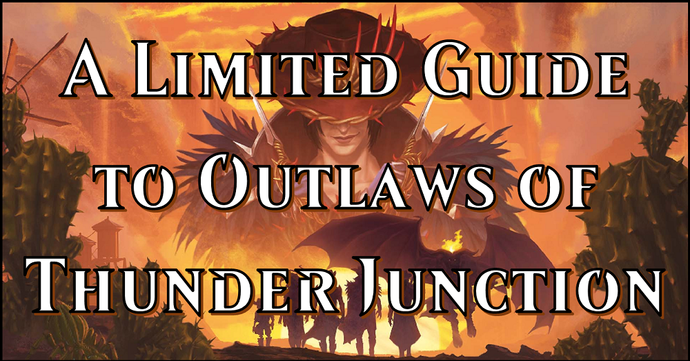
There's something bizarre about mixing Wild West tropes with Magic: the Gathering; my childhood memories of lazy weekend afternoons watching the Man With No Name slap leather against villainous scum don't quite mesh with my idea of Magic as a game about mages and dragons and fireballs. But truth be told Magic has always pushed genre boundaries, with Eldritch monstrosities and cybernetic body horror. And I admit - I was sold on Outlaws of Thunder Junction as soon as I saw that first promotional image of Vraska and Rakdos and Tinybones silhoutted menacingly against a setting sun, Oko looming large above them all with the brim of his hat pulled down low.
Keep this in mind as well: OTJ isn’t just a Magic western. It’s also a villain set, full of strange and evocative legendary creatures from across the entire Multiverse, all converging on one location for a rambunctious party full of mayhem and betrayal and gleeful destruction. How does this translate into cards? Let’s look and see!
Mechanics and Themes
Crime

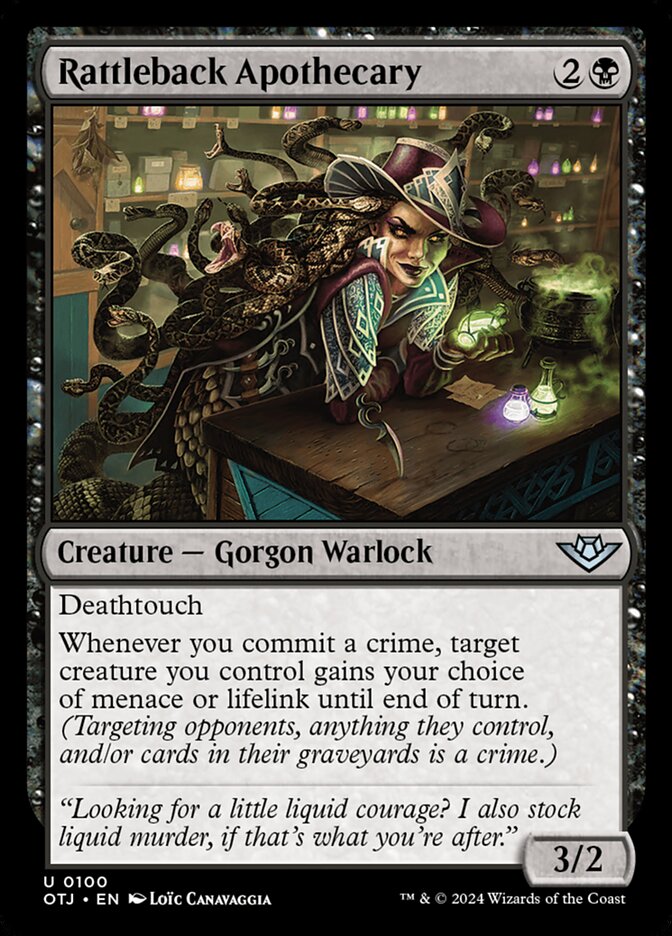
Did you know that you've been committing crimes all along in Magic? Well you have, for OTJ now formalizes a crime as an action - a spell or ability - that targets an opponent or one of their "things", whether it be their permanents, their hand, their spells, their graveyard, or their library. A targeted removal spell is a crime. So is a targeted discard spell, or counterspell, or even a pump spell directed at an opponent's creature. Notably, a board wipe that kills everything indiscriminately is *not* a crime; I guess that's just fair.
Cards interact with the notion of commiting a Crime in a variety of ways. Deepmuck Desperado creates an alternative win condition by milling your opponent, while Rattleback Apothecary grants you some nice combat buffs. In OTJ, committing a Crime is always a positive thing. Just keep in mind that many (but not all) Crime triggers are limited to once per turn.
The Crime mechanic is further emphasized in OTJ with the presence of a bonus sheet that consists entirely of cards that allow you to go do a Crime. Every pack contains one of these cards, so you can expect interaction to be fast and furious and common in this set.
Plot
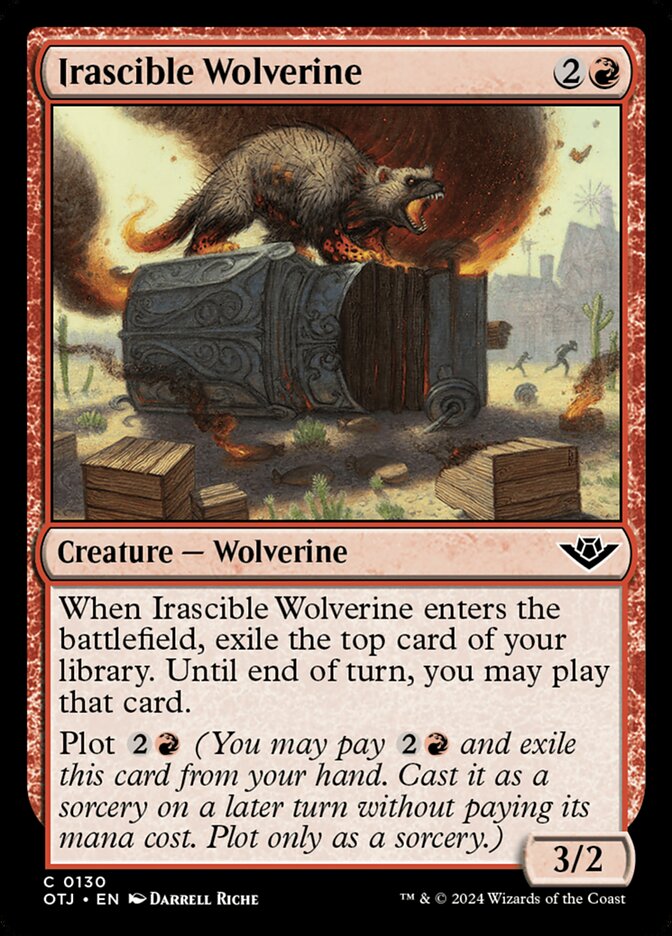
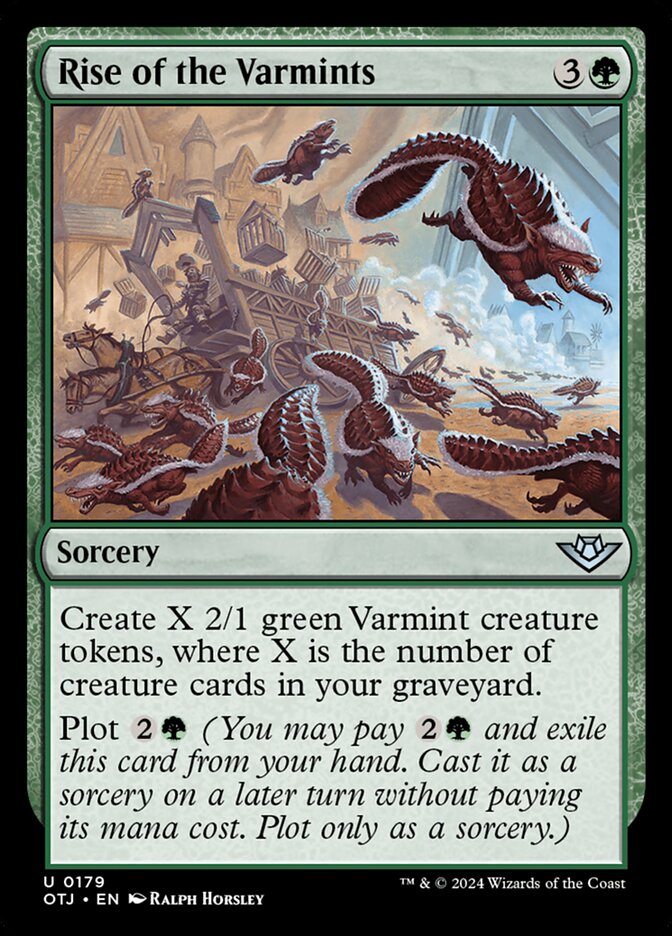
Spells with Plot may be placed into exile for their Plot cost; then they can be cast on a later turn at sorcery speed for free. Why would you want to do this? Sometimes the timing for a spell may not be quite right; for example, Irascible Wolverine’s card advantage ability is difficult to use if you’ve already spent three mana, but much easier if you have all your lands untapped. Sometimes you might want to save spells for a future turn; Rise of the Varmints grows in power if you wait for your graveyard to fill. And maybe sometimes your opponent has open mana and you’re afraid of a counterspell (note that exiling a card with Plot does *not* count as casting that spell). In each of these cases Plot allows you to avoid wasting mana or casting a spell at a non-optimal time, opening up a lot of interesting choices in a game.
Saddle
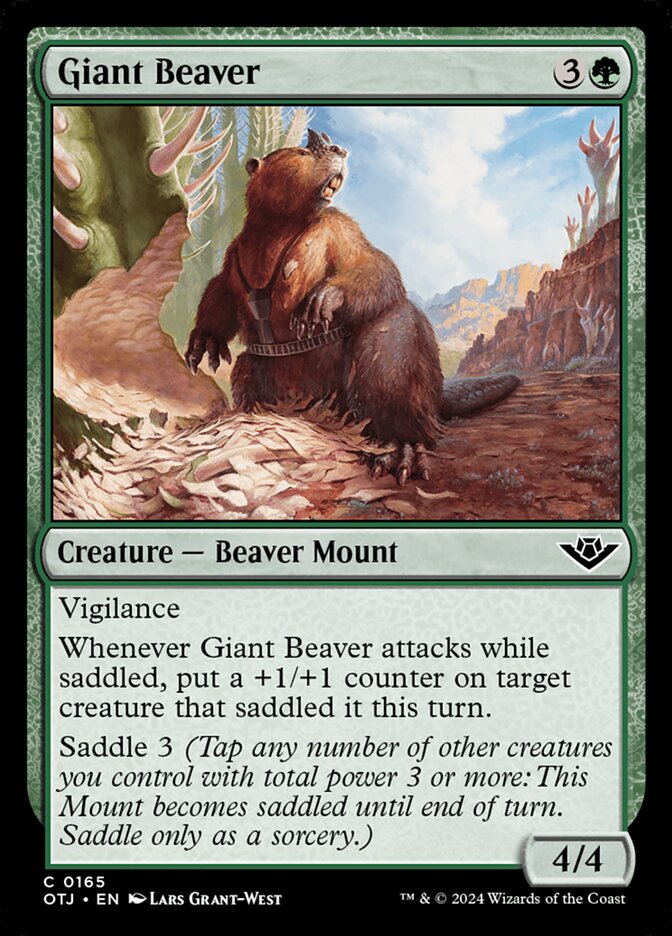

A creature with Saddle X allows you to tap any number of other creatures you control with total power X or greater (at sorcery speed). The creature then becomes Saddled, almost always gaining a bonus effect when it attacks. This bonus varies greatly: Giant Beaver’s has a +1/+1 counter effect, while Bridled Bighorn simply spits out a Sheep. Mounts are an excellent way to take advantage of small creatures that may have become outclassed on the board; just remember that their upsides can be nullified by an opponent’s instant speed interaction.
Spree


Sometimes you’re deep in a game and it’s hard to contain yourself; all you want to do is push harder and faster and more! Cards with Spree let you do that with multiple options, each of which add to the cost of the spell. When you cast a Spree card, you must choose at least one option - but you can also choose more. This means a Spree card with two options essentially has three casting modes; a Spree card with three options has seven.
Some Spree cards have unrelated effects; you’ll be happy casting Shifting Grift as soon as any one of the options works in your favor. Others have options that work well together: Rustler Rampage is fine if you cast either choice by itself, but will often work best if you can blow out an opponent by casting both together.
Outlaws
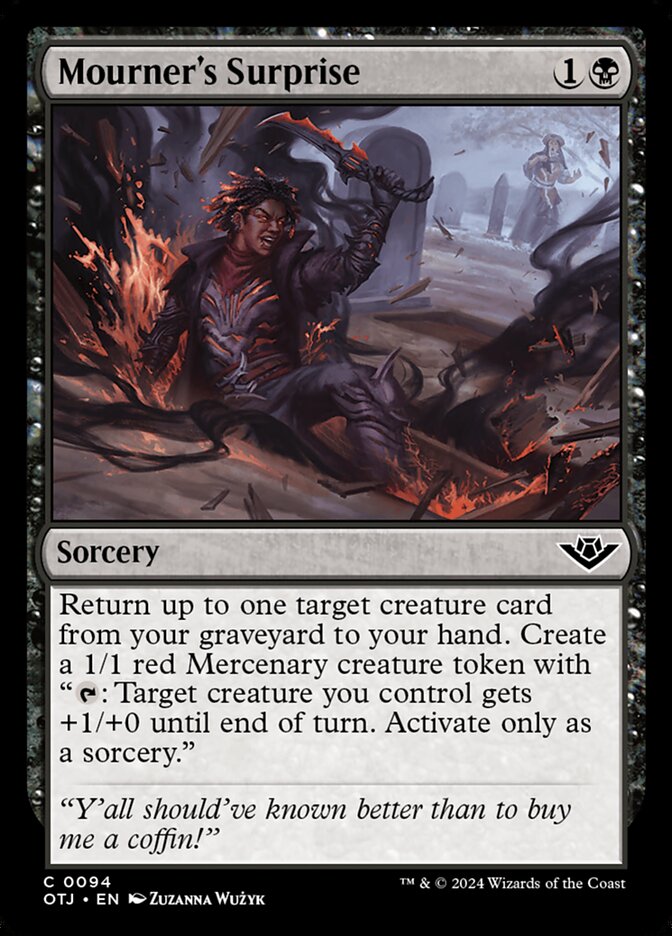


Outlaw is the latest batching keyword, bringing together Assassins, Mercenaries, Pirates, Rogues, and Warlocks. There are cards which check for Outlaws, granting bonuses (and occasionally downsides); for example, Mine Raider gives you a very nice Treasure token if you already control another Outlaw. OTJ also speeds up the production of Outlaws with the new Mercenary token - a small 1/1 creature with a buffing ability (note that this ability can’t be used on opponents’ creatures, so a Mercenary can’t commit a Crime). Lots of spells (such as Mourner’s Surprise) create a Mercenary as a side effect, so expect to see lots of these pesky creatures flying around.
Deserts


Deserts are a returning land subtype that have positive interactions with various cards in the set. Arid Archway is a good example, being a Desert that also has a triggered ability that grants a slight bonus if you use it to bounce another Desert. Failed Fording is another card that gives you upside for controlling a Desert, and you’ll find a bunch more in the set. Keep an eye out for these lands, and you’ll be rewarded!
Treasure
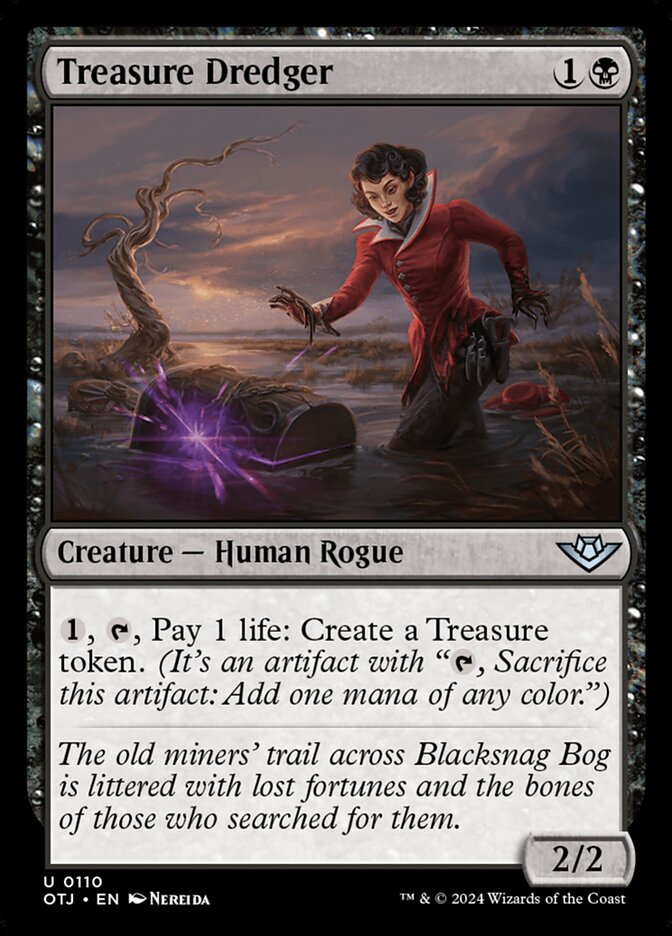
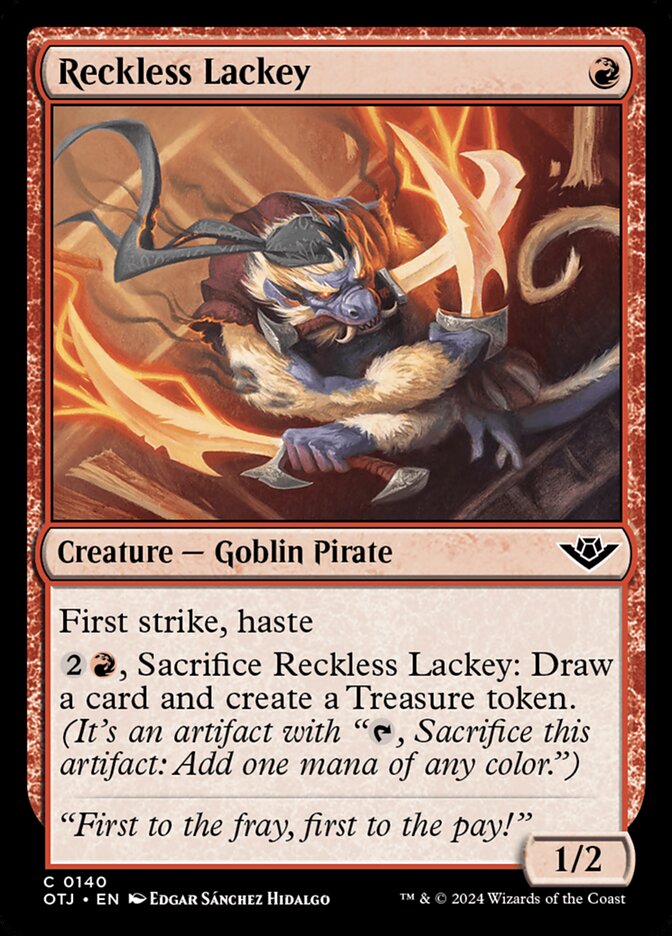
Recent Limited sets have almost all featured one artifact token or another. In OTJ it’s the ever-popular Treasure token, and you’ll find that there’s a variety of ways to generate Treasure - everything from Treasure Dredger’s repeatable activated ability to Reckless Lackey’s stirring sacrifice ability. You’ll find a variety of ways to use Treasure as well. Mana fixing and ramp are the obvious ones, but there are a smattering of sacrifice cards for which Treasures are the ideal victim.
Archetypes
Each two color archetypes has two signpost uncommons, with one being a legendary creature.
White / Blue: No Spells From Hand
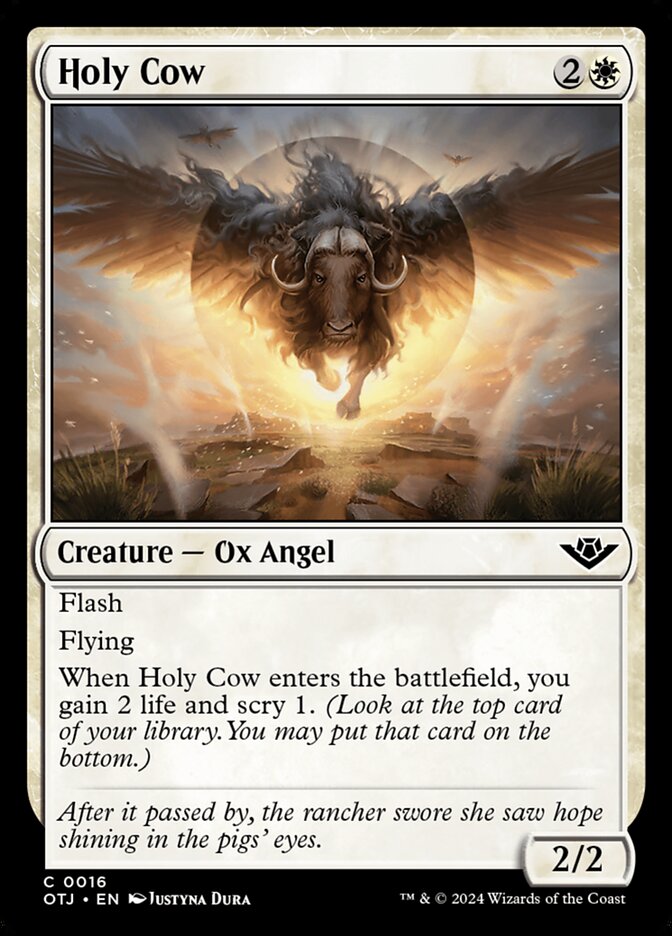

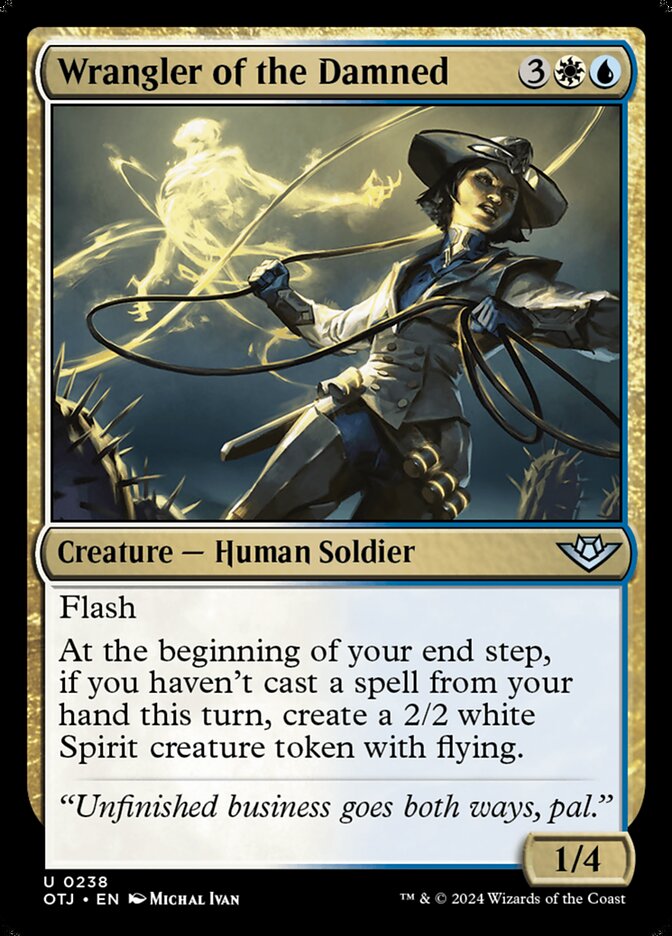

If you play constructed, you know that White/Blue control players love to drop a land and then end their turn with sly smiles on their faces. If you’re one of these monsters - I mean players - then good news! That’s pretty much what the color pair’s OTJ archetype asks you to do. Both Jem Lightfoote, Sky Explorer and Wrangler of the Damned give you nice rewards for passing your turn without casting a spell from hand, and they provide evasive threats and defensive bodies to boot. Emergent Haunting is another card that fits into this theme; note that once it becomes a creature, it’ll stay a creature as long as it remains on the battlefield. Naturally you’ll want to load up your deck with instants, but note that Plot cards work as well since a Plotted card isn’t casting from hand. Better yet is Holy Cow: a flash flyer chock full of excellent “enter the battlefield” abilities.
White / Black: Tokens / Sacrifice

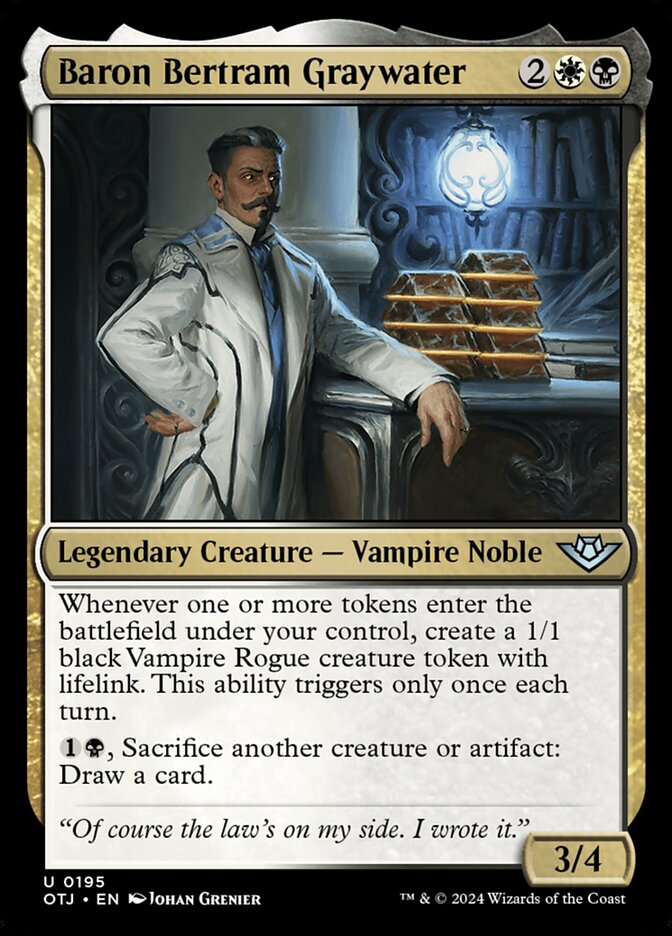
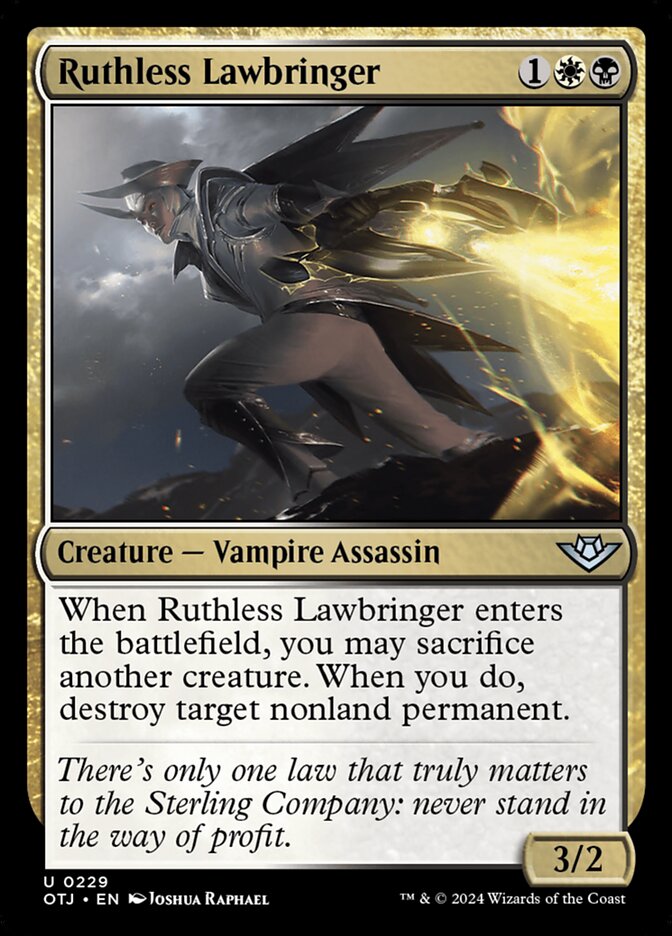
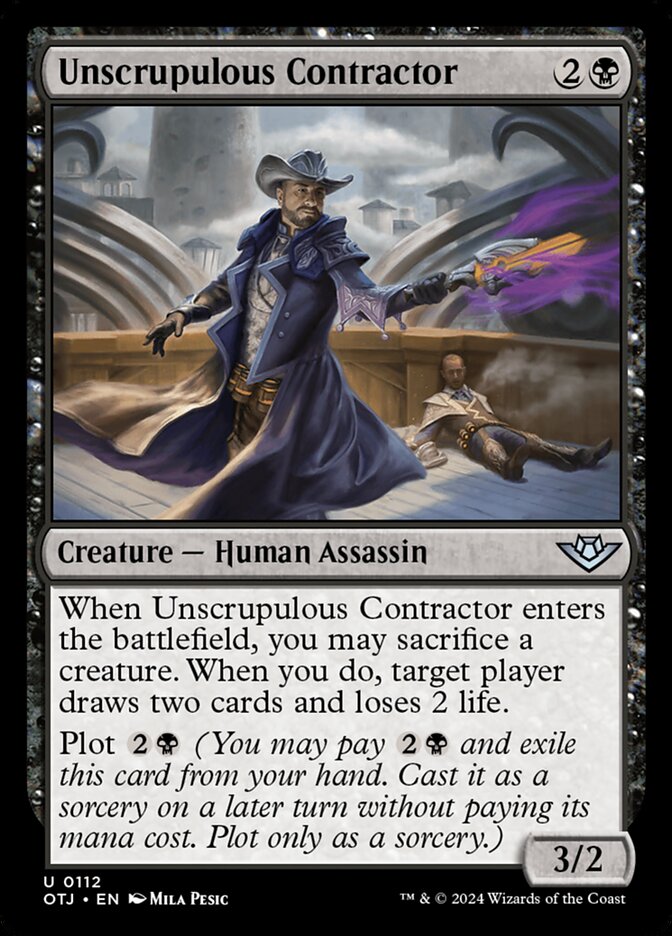
Tokens are great and all, but they can have trouble busting through a wall of bigger creatures. That’s why a token strategy is often paired with a sacrifice theme, and that’s exactly what White/Black wants to do in OTJ. Baron Bertram Greywater extends your token production while giving you a powerful way to use them. Ruthless Lawbringer isn’t as flexible, but its ability to sacrifice a creature (hopefully a cheap token) in return for destroying any of your opponent’s nonland permanents - well, that’s a hell of a deal. Unscrupulous Contractor provides another nice reason to sacrifice your creatures (and can even snipe an opponent who’s low on life), but remember there are other ways to make use of your tokens. Build up an army, take the game late, and Bounding Felidar can turn a stalled board into one that is irreversibly favorable for you.
Blue / Black: Crime Control
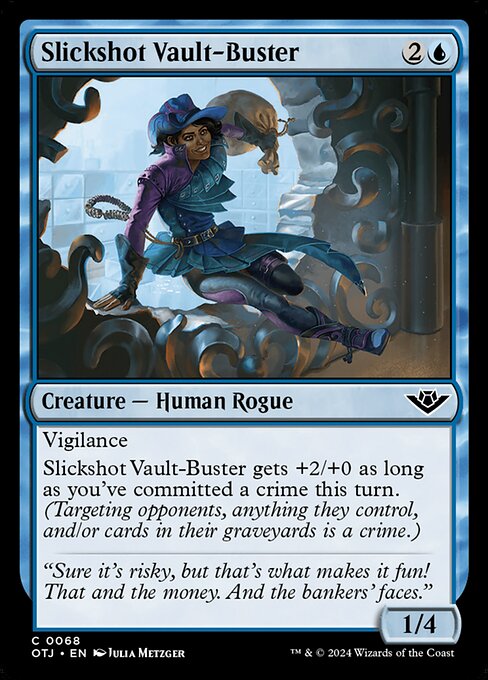
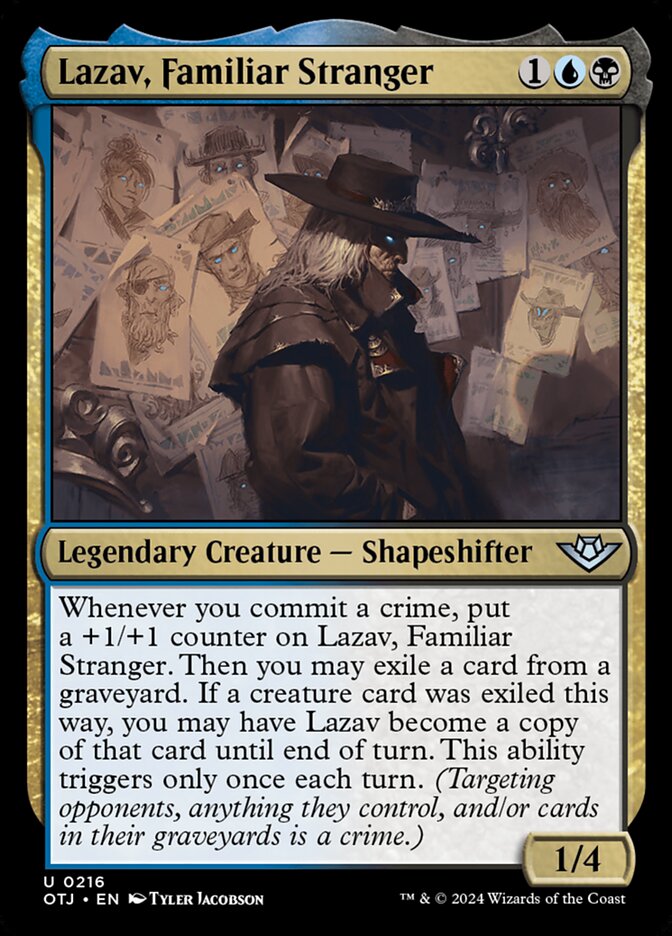
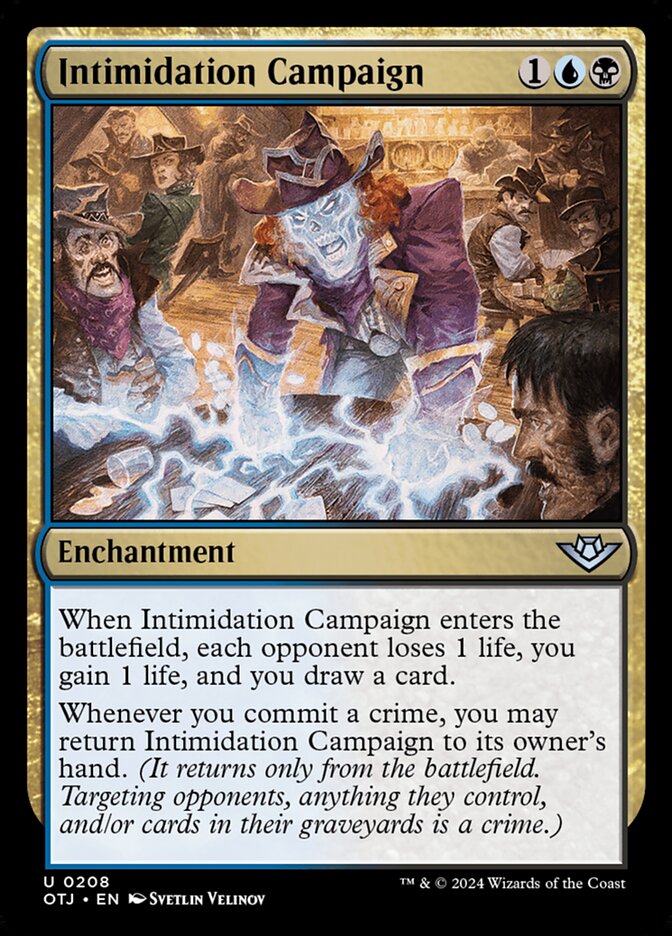
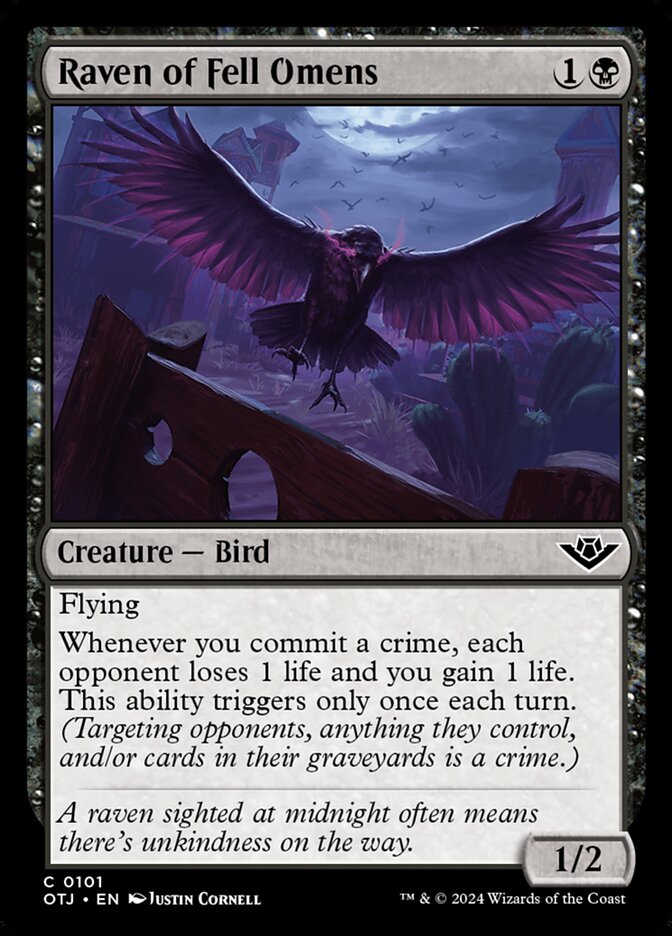
Some Crimes are committed for immediate gratification; some Crimes are part of a long-term plan for domination. The Blue/Black strategy falls into the latter category, with Lazav, Familiar Stranger slowly growing larger with each Crime (and potentially turning into a much larger threat), and Intimidation Campaign providing steady card advantage. Raven of Fell Omens works well with this strategy: a cheap flier that also slowly drains an opponent down towards nothing. And Slickshot Vault-Buster gives you a nicely defensive creature that can turn into a strangely aggressive threat.
Blue / Red: Double Spell
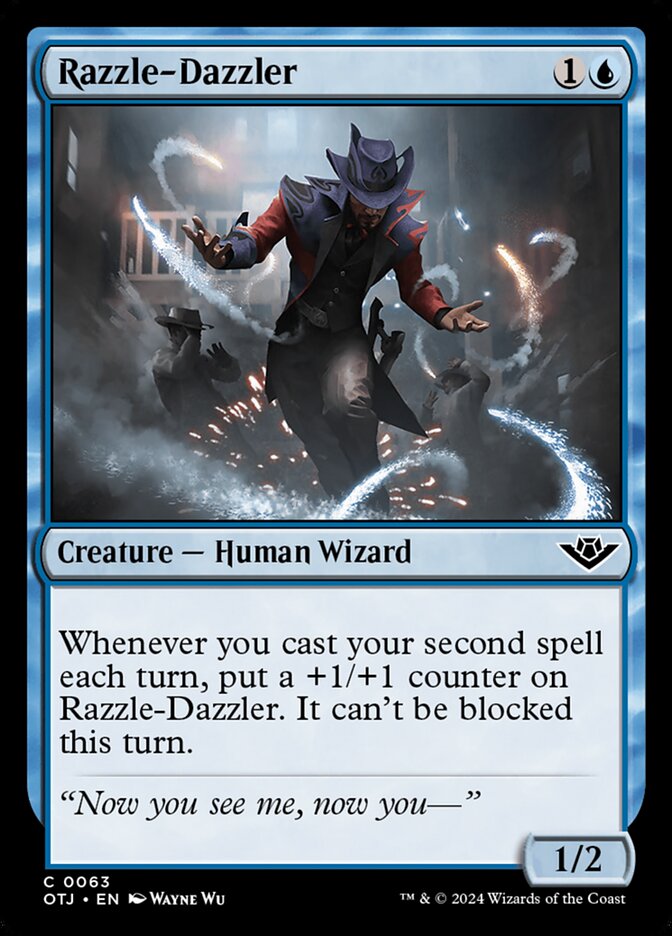
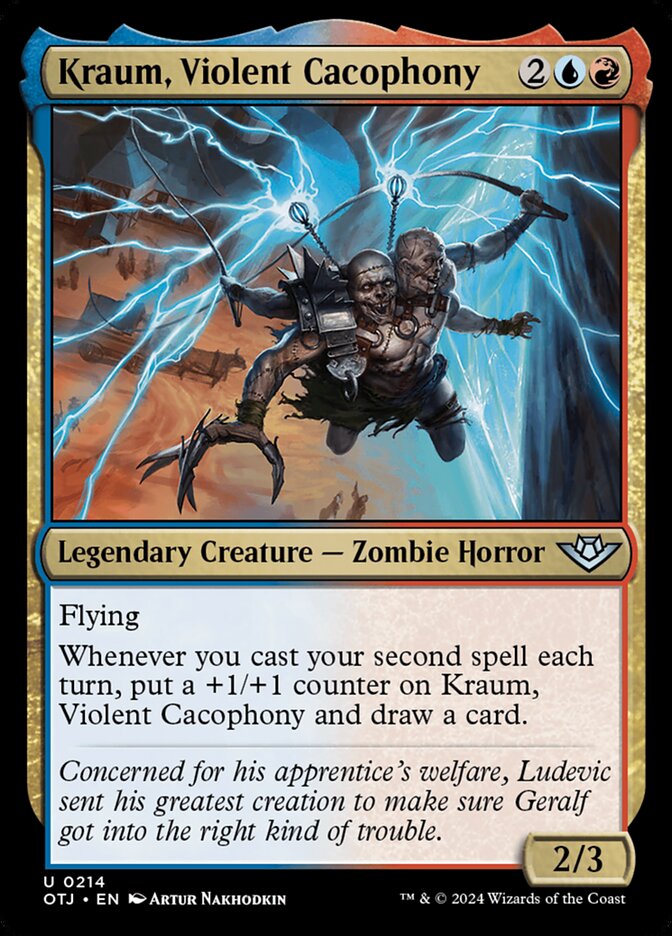

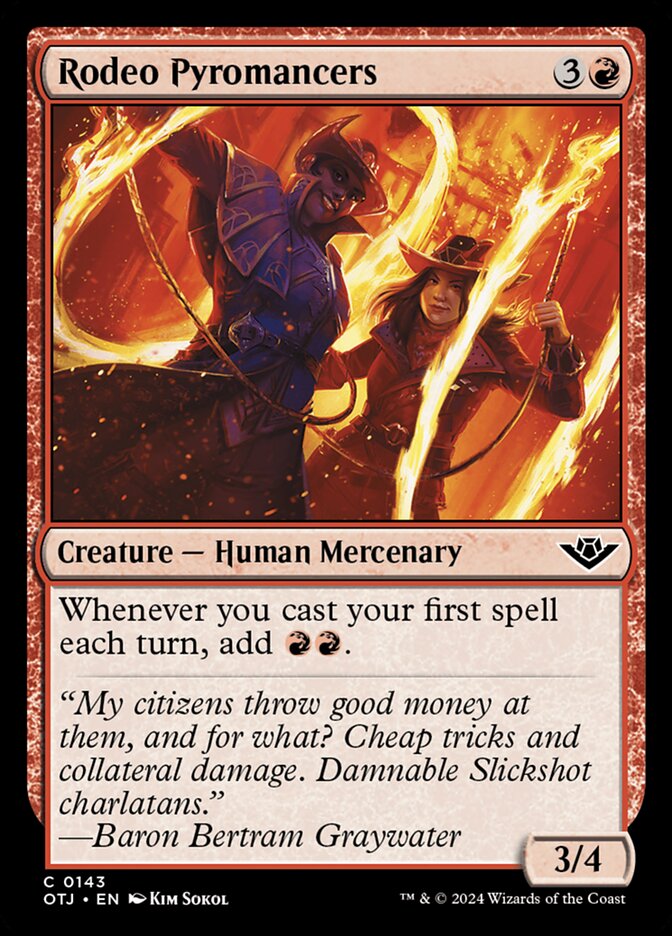
Well, Kraum, Violent Cacophony makes it pretty obvious what you want to do with Blue/Red in OTJ. What may not be obvious at first is that it’s actually not that hard to trigger its delicious +1/+1 counter and card drawing ability the turn you play it; just Plot a card in an earlier turn, and you’re set. Slick Sequence is similar - a slightly overcosted removal spell that rewards you for casting other spells before it. Keep your storm of spells going, and early drops like Razzle-Dazzler will quickly whittle down an opponent’s life total. And you won’t always need to rely on Plot to have the mana for double spells; Rodeo Pyromancers gives you a nice little mana boost that will help cards fly out of your hand.
Black / Red: Aggressive Outlaws
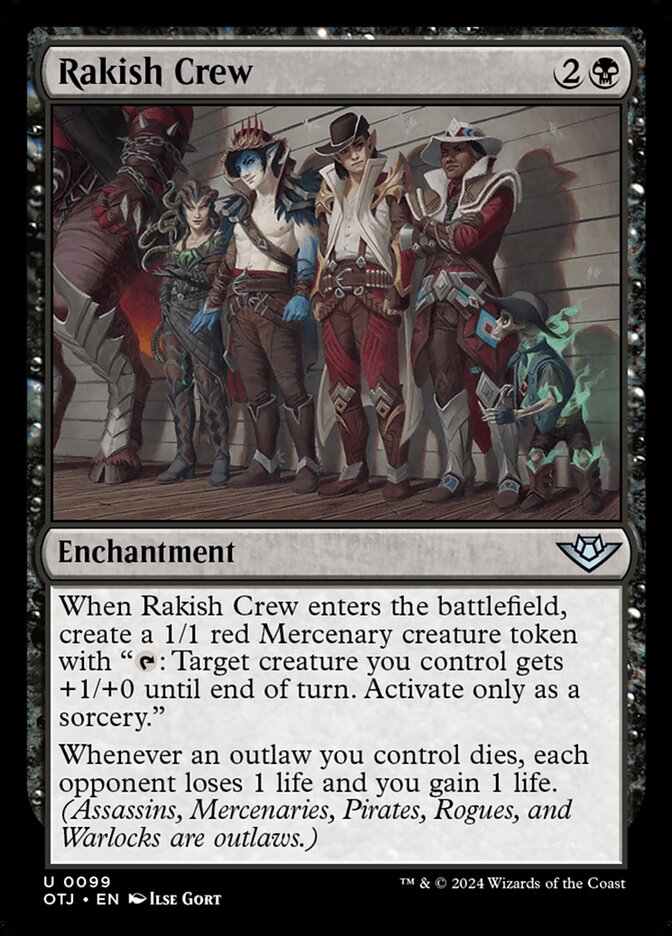
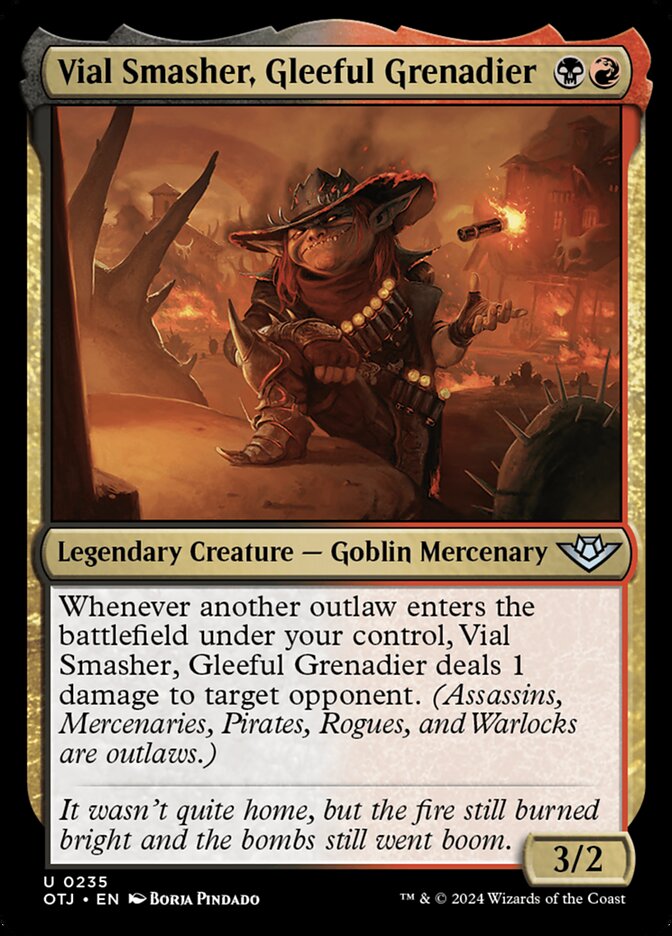

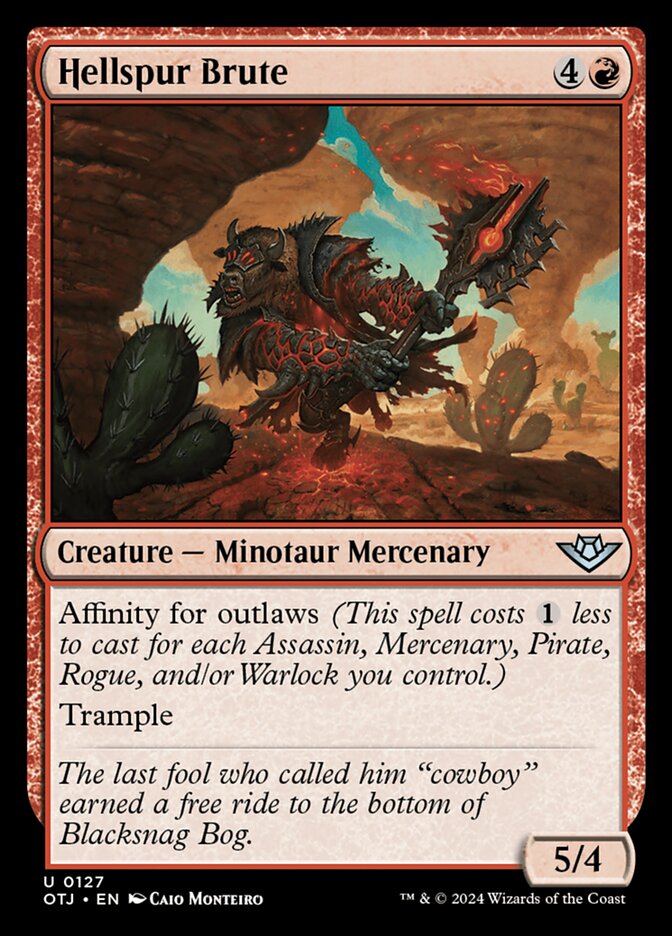
Red/Black is the archetype for Outlaws that want to cut your throat quick. Play Vial Smasher, Gleeful Grenadier, dump your Outlaws onto the battlefield, and watch your opponent’s life dwindle (and note that Vial Smasher’s ability counts as a Crime). At Knifepoint adds pressure by giving your Outlaws first strike on your turn, encouraging highly aggressive gameplay; more than that, it generates additional Outlaws whenever you commit a Crime. From there, it’s your choice how you want to close out games. You can play the big trampler Hellspur Brute way ahead of curve, or lay down Rakish Crew and watch your opponent’s face crumble when they realize there’s no way to prevent their life from draining away.
Black / Green: Graveyard Value
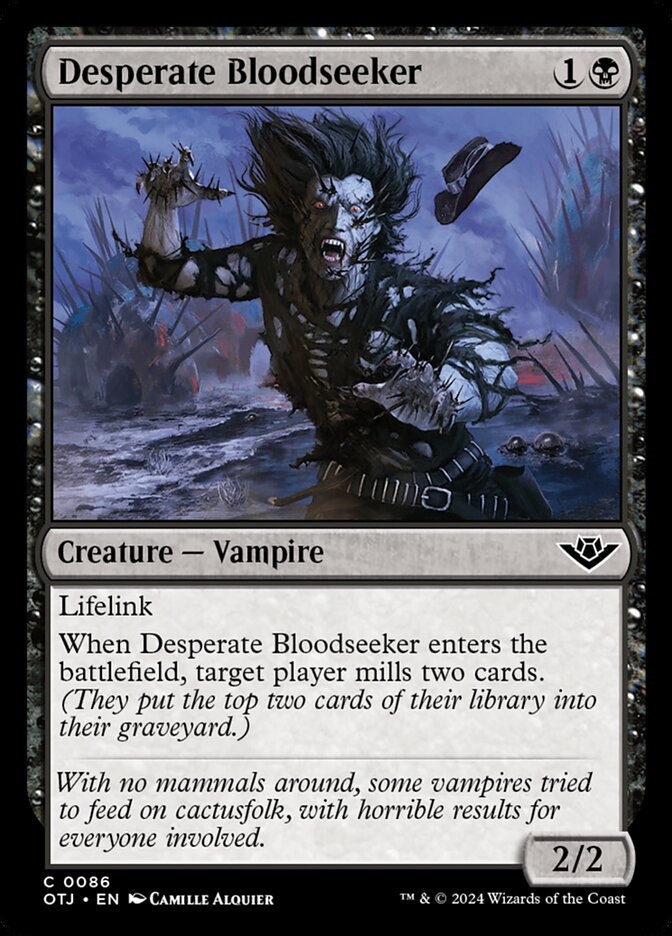
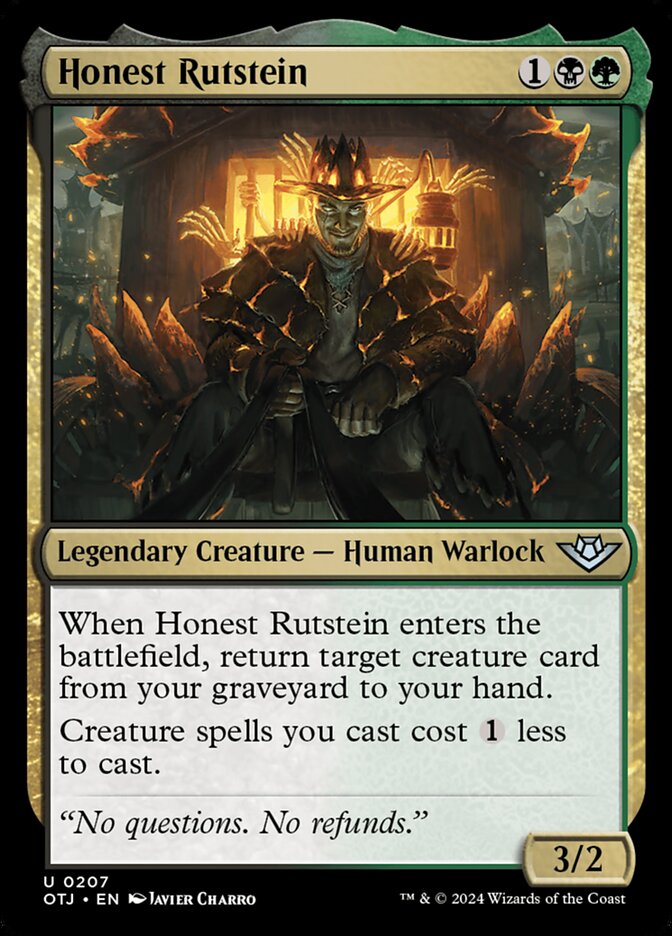

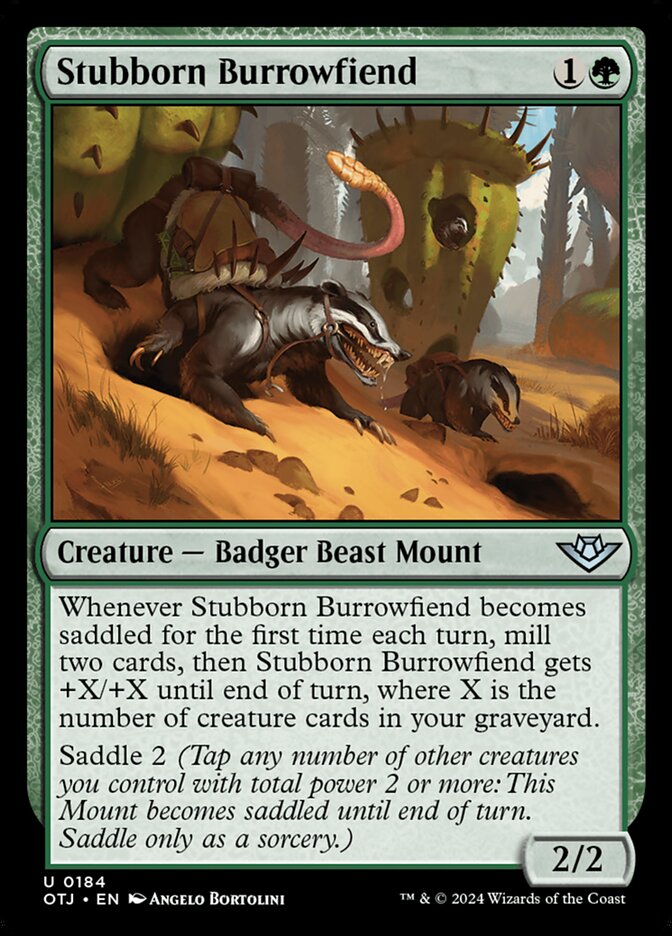
Not all archetypes in a set can be original, and Black/Green certainly isn’t. It’s long been the color pair for graveyard value, and both Honest Rustein and Badlands Revival give you exactly that. What’s slightly different is that there’s a bit of an aggressive spin here, as Honest Rustein lets you play creatures above curve, giving you the ability to start some truly heinous beatdowns. However both these cards only truly excel if there are already creatures in your graveyard, and that’s where Desperate Bloodseeker and Stubborn Burrowfiend come in: cheap cards that start stocking your graveyard nice and early.
Red / White: Mercenaries

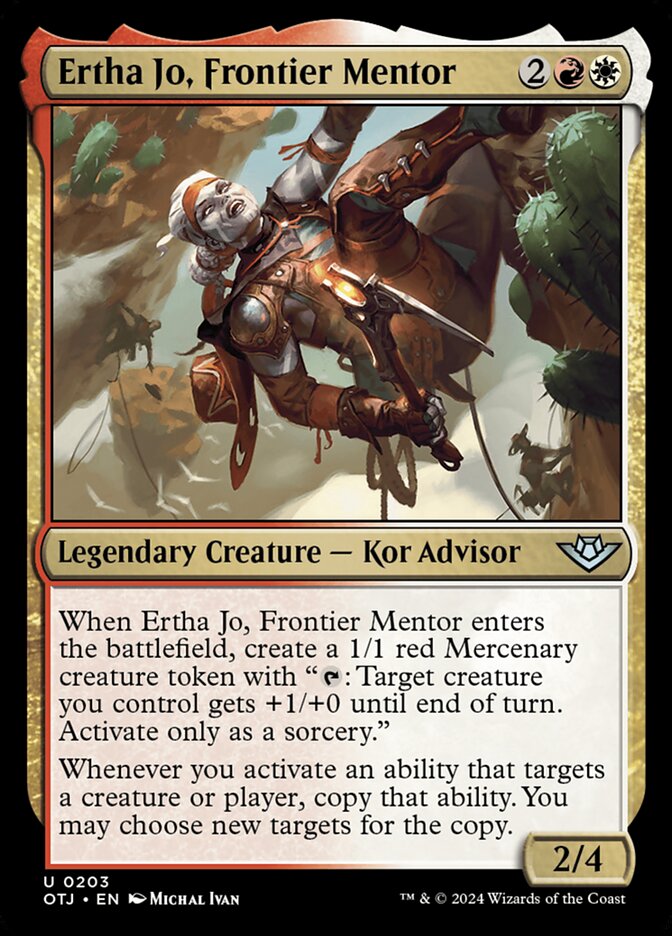
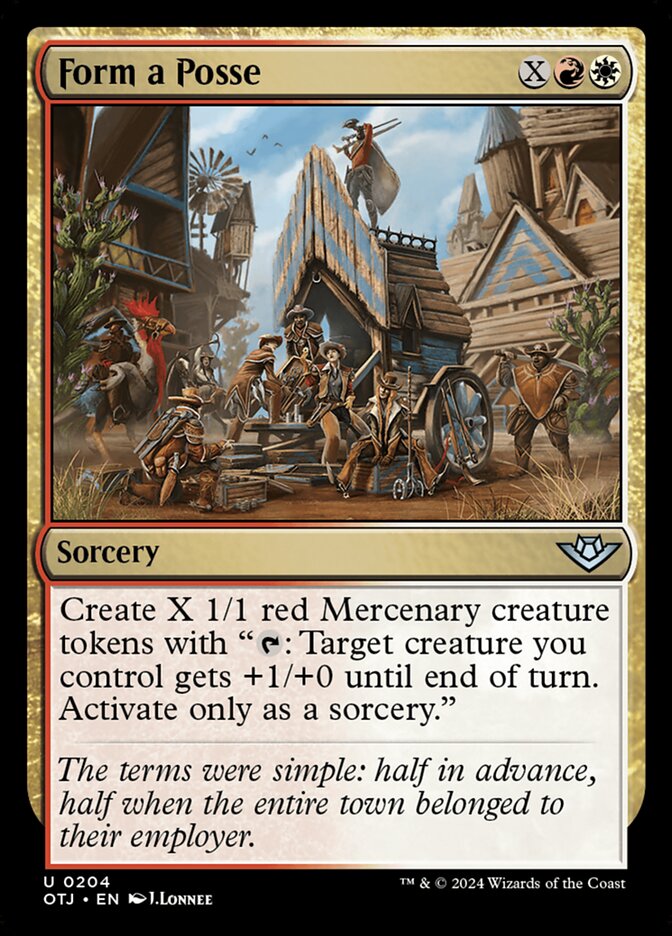

Not all Outlaws are focused purely on murder; some Mercenaries care more about helping each other. Ertha Jo, Frontier Mentor both creates a Mercenary and doubles the effect of their activated ability (as well as most of your other targeted activated abilities). That’s pretty good, and if you Form a Posse you can spit out a ridiculous number of Mercenaries. Of course a bunch of 1/1s might not be enough to get the job done, which is why it’s nice to have a backup plan. Outlaws’ Fury is a nice mass buff for your team that is also likely to (kind of) draw you a card; and Vengeful Townsfolk is a three mana 3/3 that will grow quite big if your army is whittled down to size.
Red / Green: Power 4 or Greater
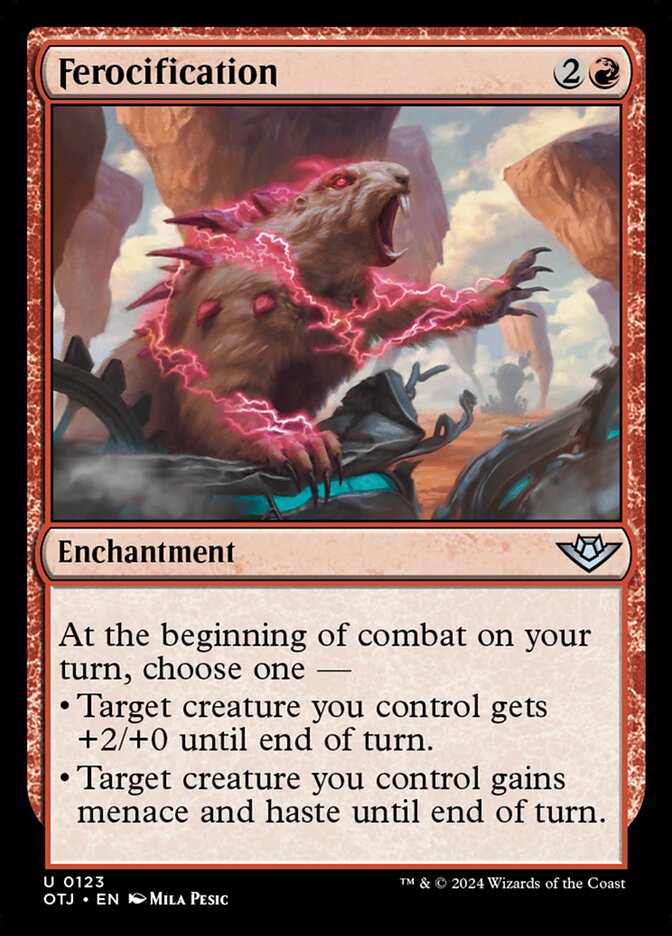
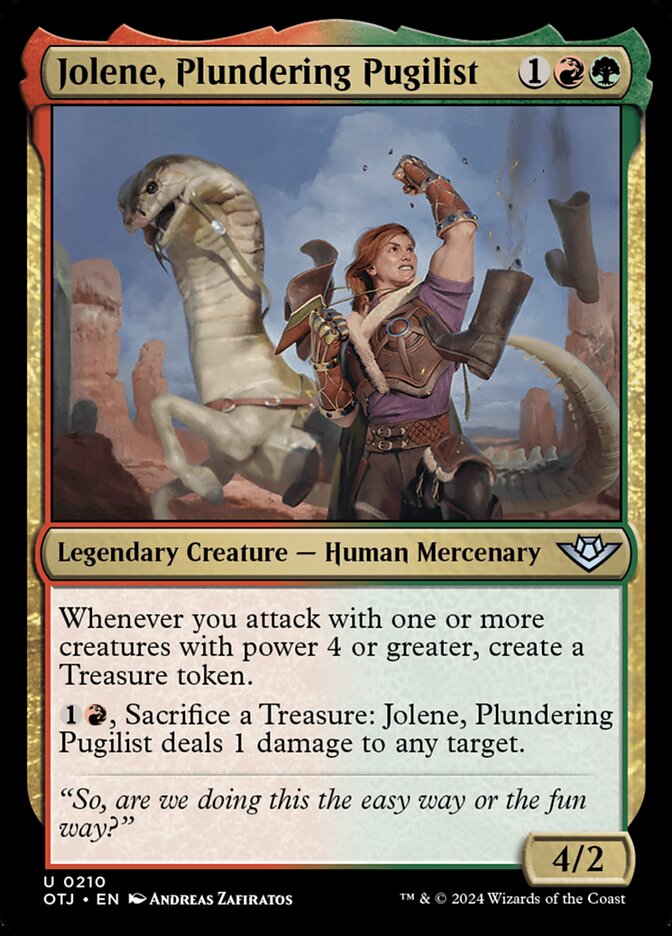

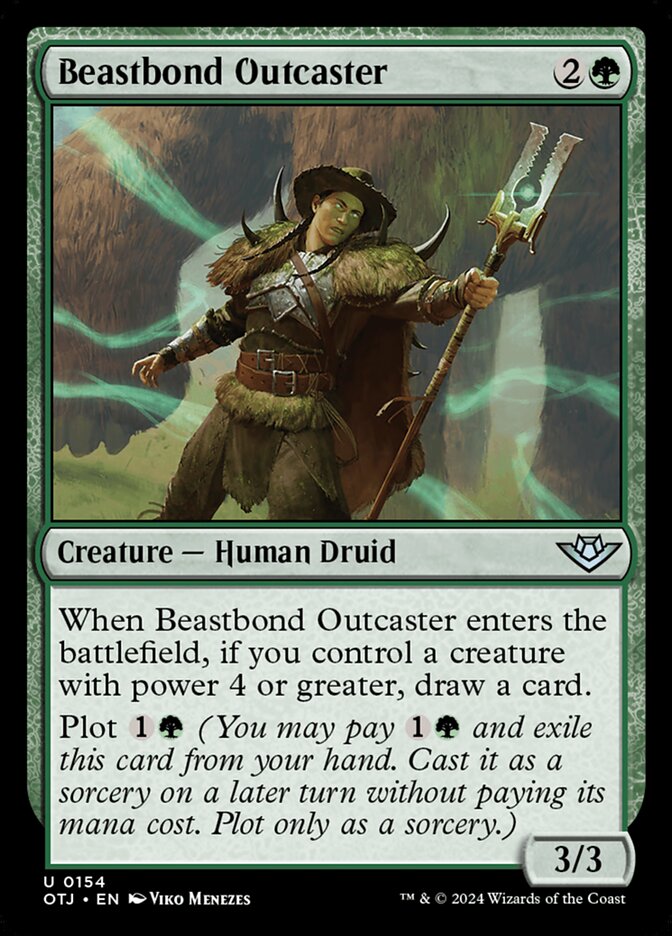
Red/Green gets another traditional archetype: power 4 or greater matters. Jolene, Plundering Pugilist showcases this strategy in a straightforward manner, granting you Treasures which can either be used to commit a Crime by pinging opponents’ targets, or to simply ramp out bigger and bigger threats. Is your opponent planning to chump your giant threats with a swarm of Mercenaries? Cactusfolk Sureshot laughs at that idea, ensuring your big creatures can simply trample past tiny blockers. No deck can live on big creatures alone, however; you’ll still need small two drops to make sure you survive the first few turns. Even so, Ferocification will enable those small creatures to grow into big ones. And if you have the time to spare, Plot creatures like Beastbond Outcaster to garner some sweet sweet card advantage.
Green / White: Mounts
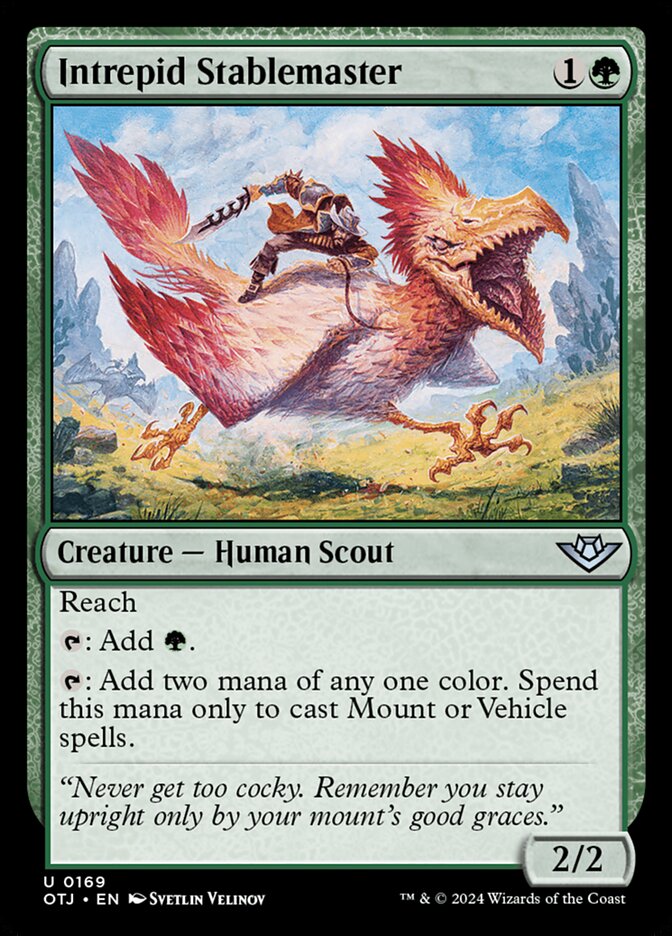



Yes, Miriam, Herd Whisperer works with Mounts and Vehicles, and yes, there are a few Vehicles in OTJ. But make no mistake: the Green/White archetype is focused on Mounts, and Miriam will let you charge in on the attack with some reasonable assurances that they’ll be safe from your opponent’s dastardly tricks. Put enough Mounts on the battlefield, and Congregation Gryff becomes an extremely powerful threat whose lifelink almost guarantees that you will win any race. There’s not a ton more to say about this archetype: grab Mounts, look for cards like Intrepid Stablemaster and Shepherd of the Clouds that interact well with them, and ride your way to victory!
Green / Blue: Plot Plot Plot


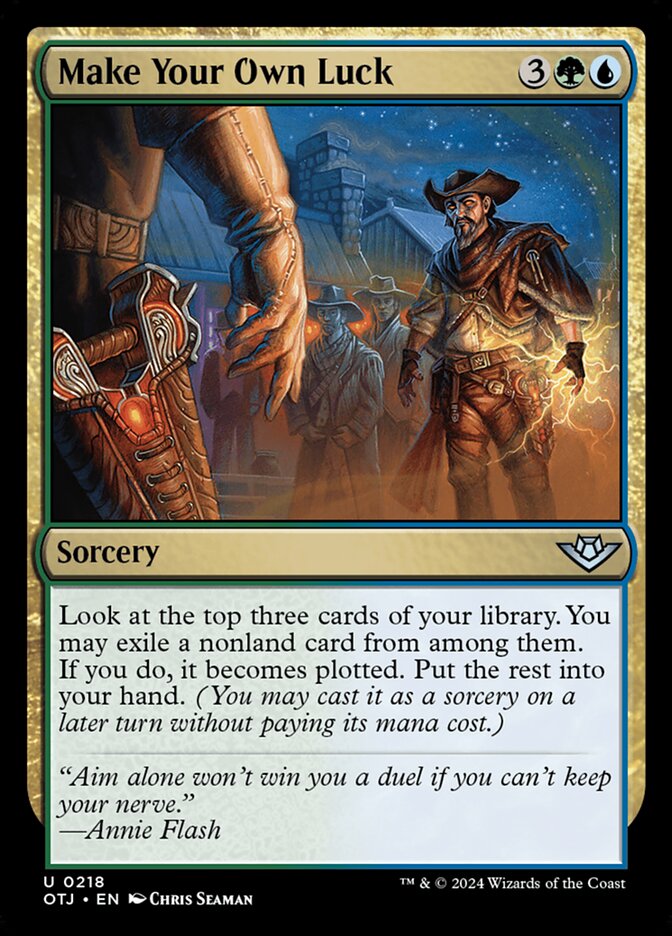

The Plot mechanic is fundamentally slow, as it spends mana now for an effect later. That makes it perfect for the Green/Blue archetype. But a strategy can be both slow and explosive: Doc Aurlock, Grizzled Genius allows you to Plot a bunch of cards waaaaay ahead of curve, potentially creating a board state so advantageous that your opponent will have no hope of recovery. But even if you don’t have an explosive turn 3 or 4, you can still use the color pair’s value cards. Make Your Own Luck may not do much the turn you cast it, but its card draw and Plot clause means that your next turn is likely to be overwhelming. Beyond that you want cards that are okay if you cast them in the first few turns, and potentially game ending if you cast them late. Both Tumbleweed Rising and Slickshot Lockpicker fit this criteria: you can use them early for survival’s sake, and cast them late for excessive value and efficiency.
Key Commons and Uncommons
White
Creatures
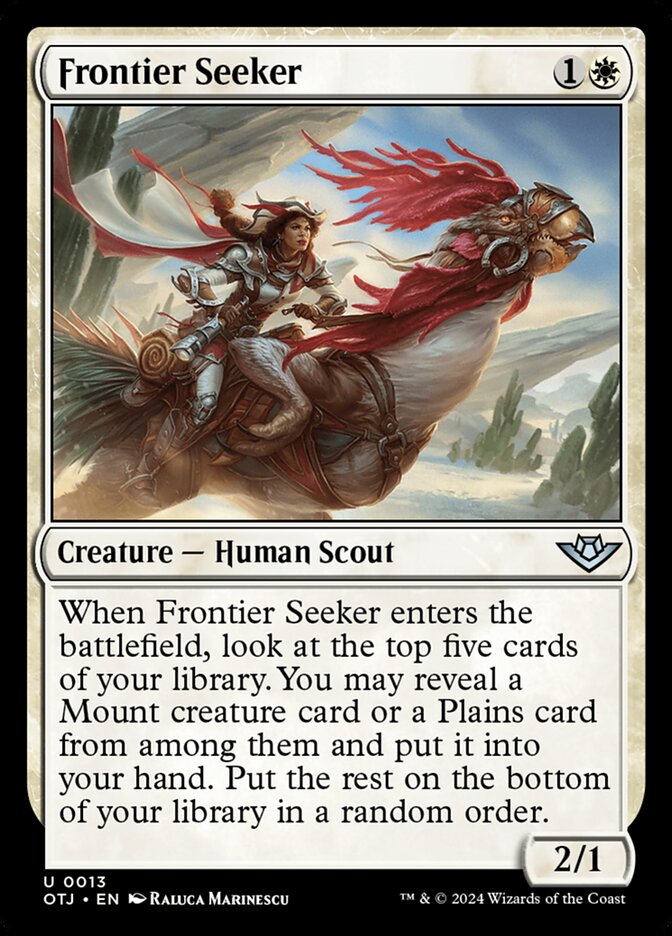
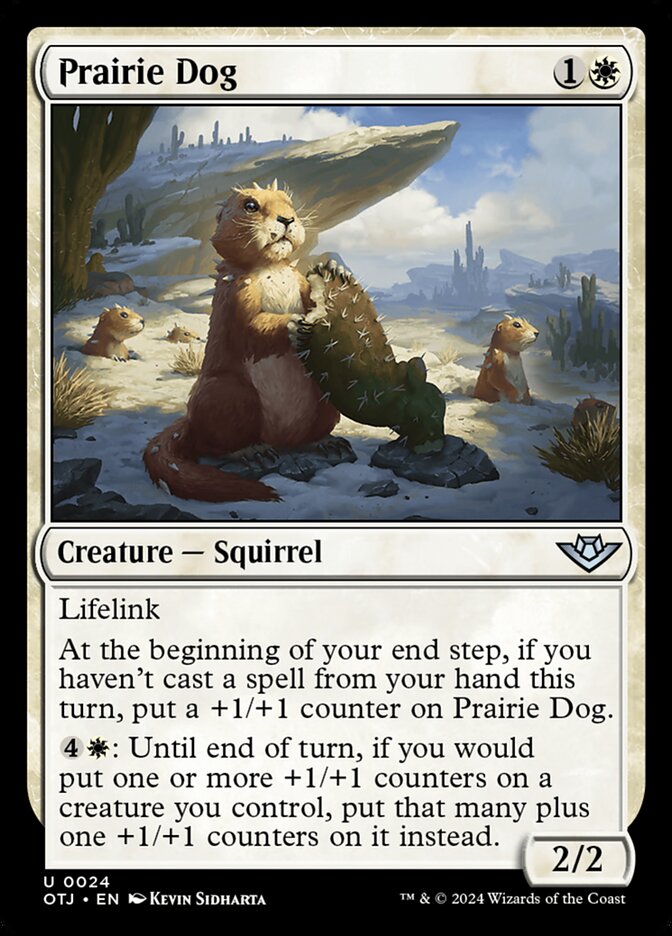

Frontier Seeker: Hey, it’s a two drop that (likely) draws you a card.
Prairie Dog: A 2/2 creature with lifelink for two mana is decent, but it’s this critter’spotential to grow (and grow and grow) that makes it intriguing.
Stagecoach Security: I’ve played with lots of creatures like this before, and trust me: they are game enders.
Non-Creature
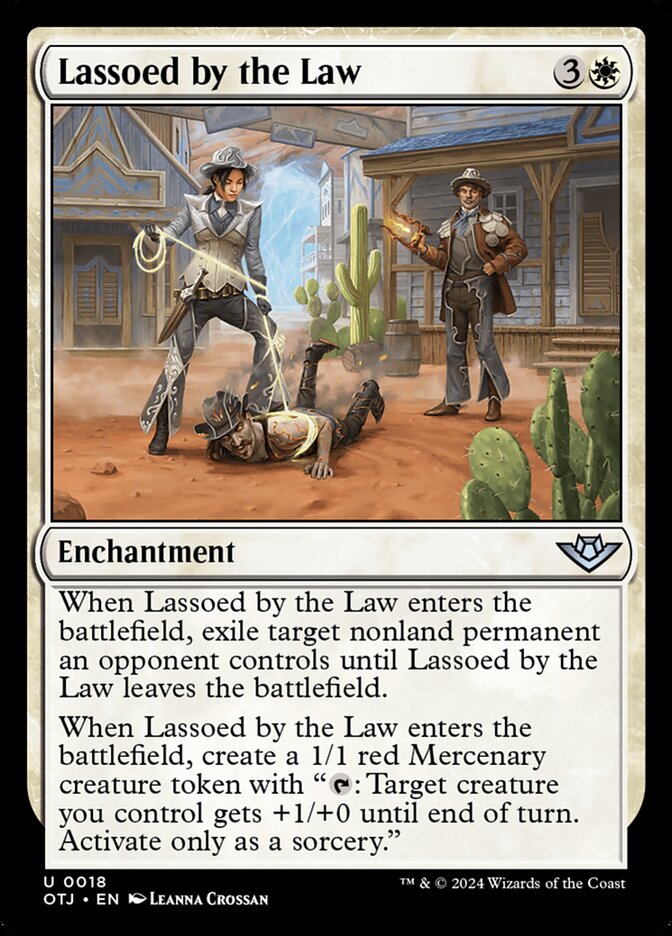
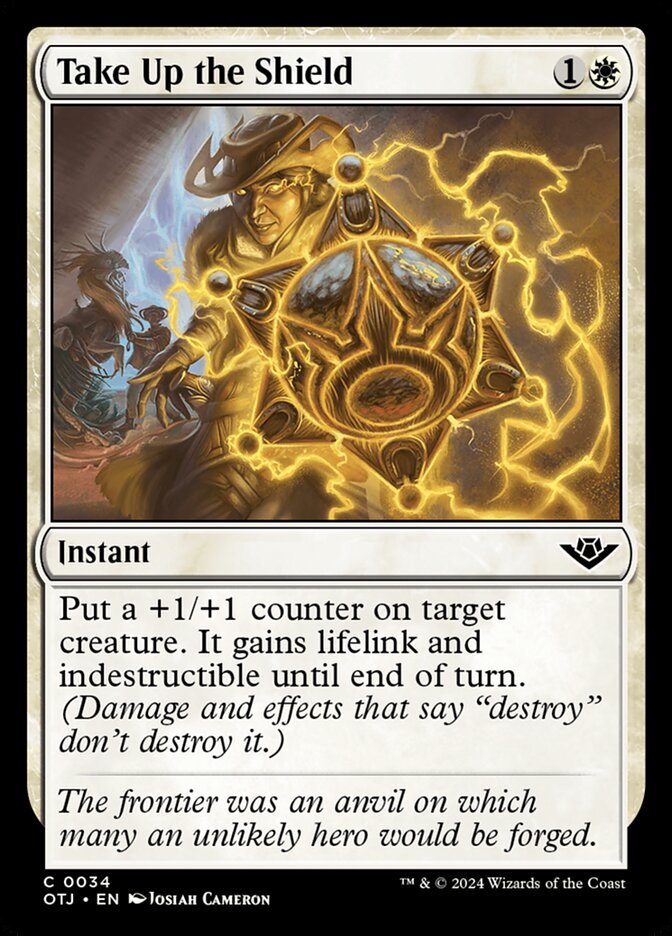
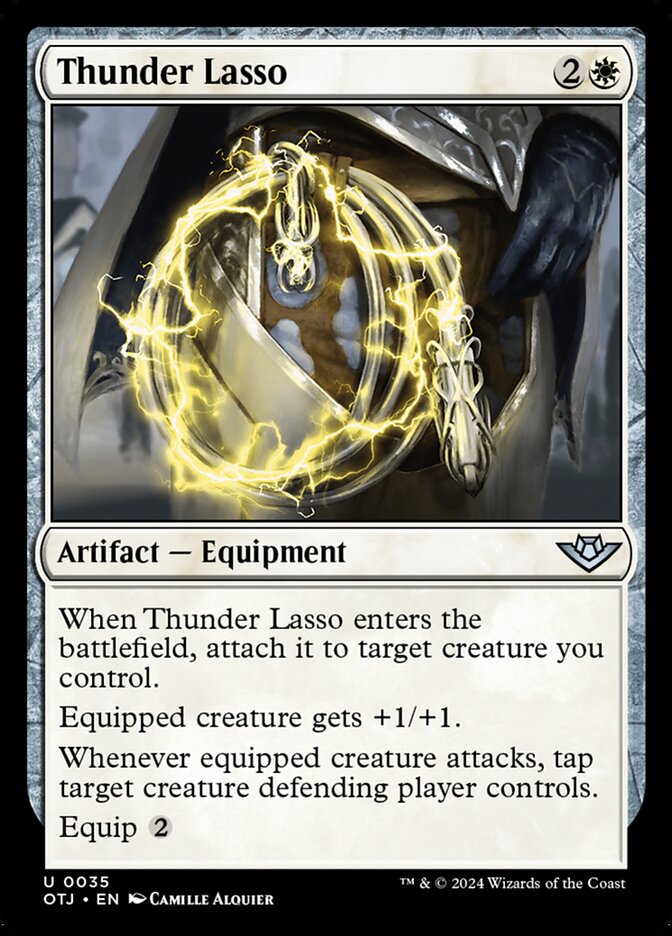
Lassoed by the Law: Well, here’s your White enchantment that unconditionally removes an opponent’s permanent. This one comes with a free Mercenary too!
Take Up the Shield: This card was nuts in Dominaria United. I think it’ll be less good in OTJ due to the amount of interaction - but if you’re judicious about when to cast this spell, you’ll likely blow out your opponent (and get a nice chunk of life to boot).
Thunder Lasso: Skeptical about this Equipment? You’ll realize your error when you’re trying (and likely failing) to defend against this very very annoying card.
Blue
Creature
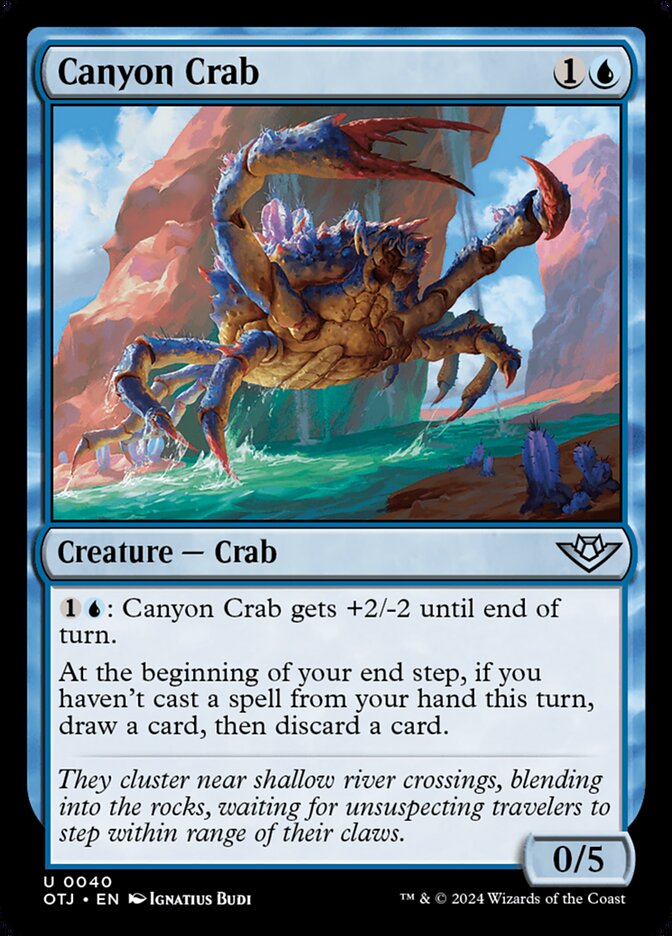
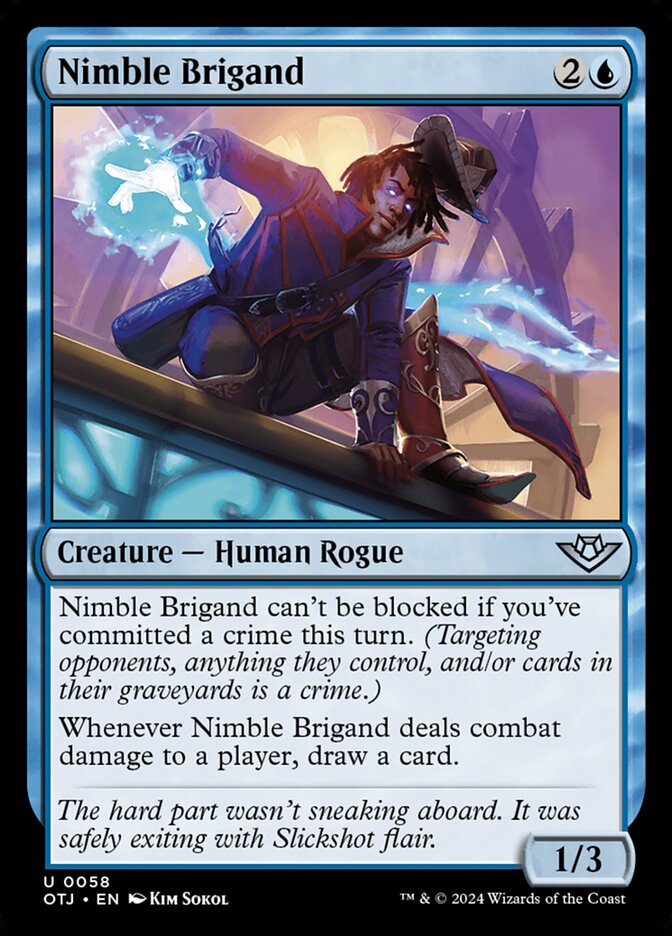
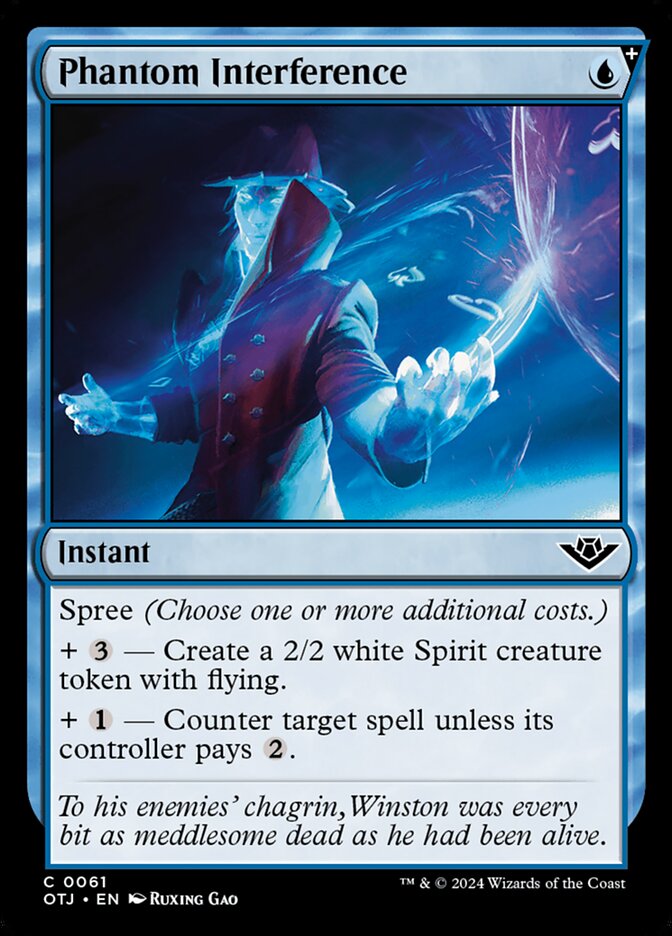
Canyon Crab: It’s not everyday that I rate a 0/5 so highly, but all of Blue’s archetypes are slow with a good dose of Plot involved. You need an effective way to live long enough for your plans to come to fruition, and this creature does that job extremely well. It also has considerable additional upside with its (conditional) looting ability and its potential to become far more aggressive later in the game.
Nimble Brigand: I may be overrating this card; after all, Blue players never enjoy messing with their opponent’s things while drawing cards.
Phantom Interference: I’ll count this instant as a creature, even though I won’t hesitate to use it as simply a cheap taxing counterspell if the situation calls for it. It’s that flexibility that makes this card so strong!
Non-Creature
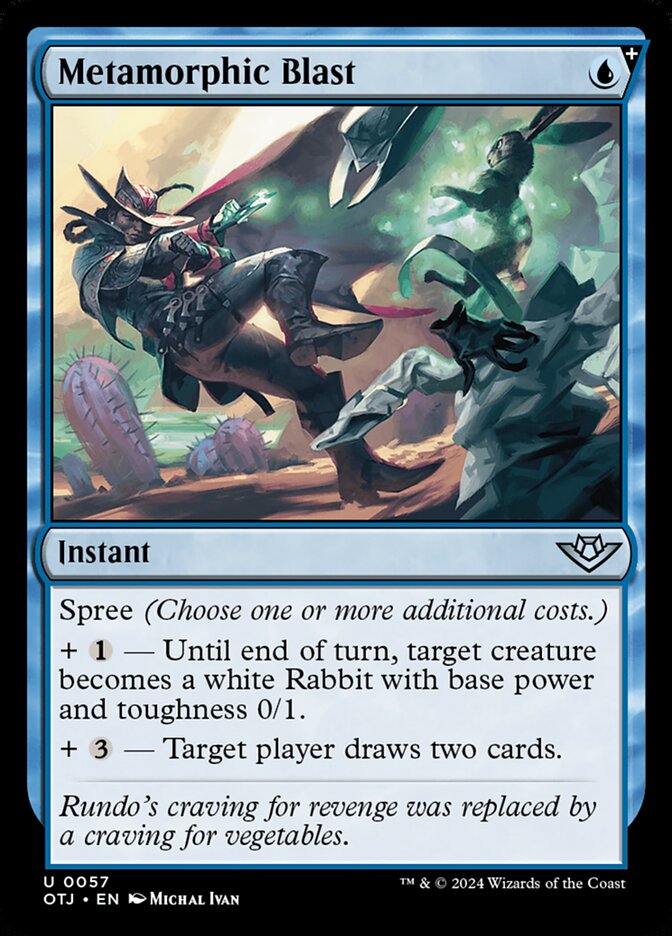
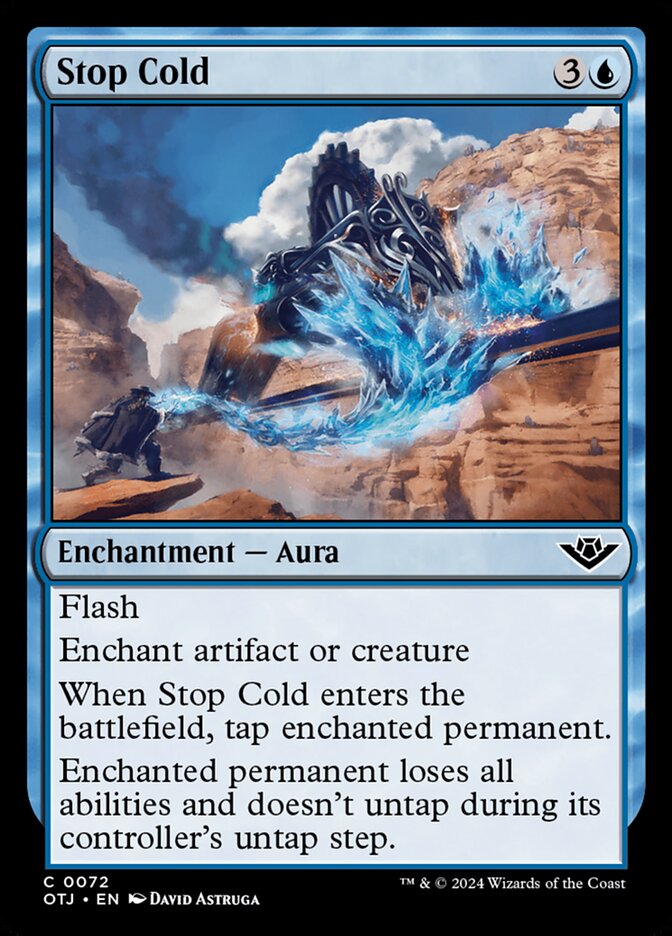

Metamorphic Blast: This instant isn’t quite a removal spell - but it’s close enough to provide insane value in conjunction with its card drawing effect.
Stop Cold: Blue’s “permanent” removal often feels like a necessary evil. But it often gets the job done, and this Aura’s nullification of abilities is a strong plus in a set with so many creatures with wild text boxes.
Take the Fall: Power reducing instants are also not really removal spells - but cheap ones that draw you a card are essentially card neutral in their worst case, and wonderfully positive in their best.
Black
Creature
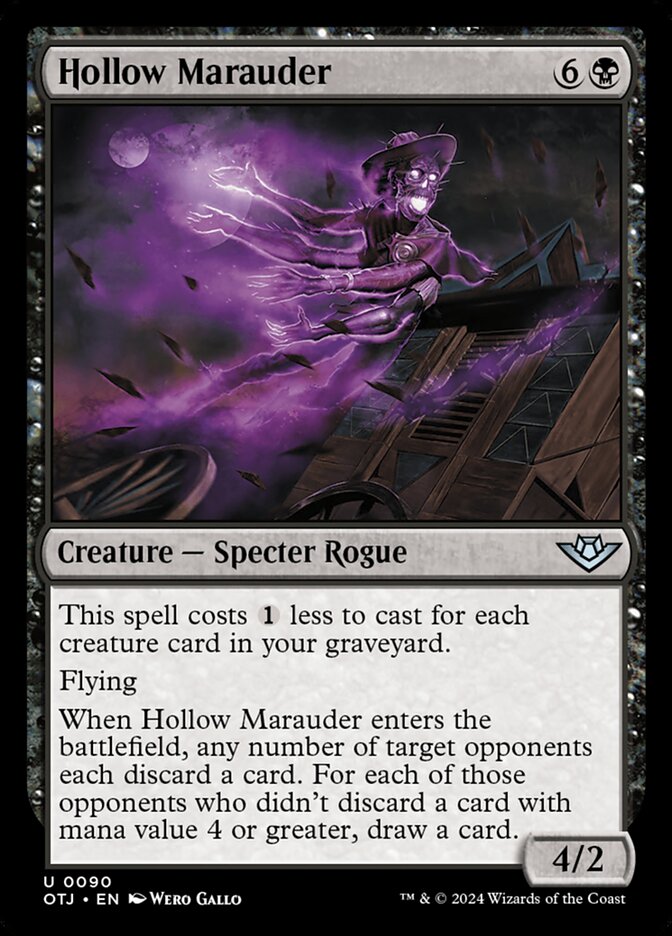
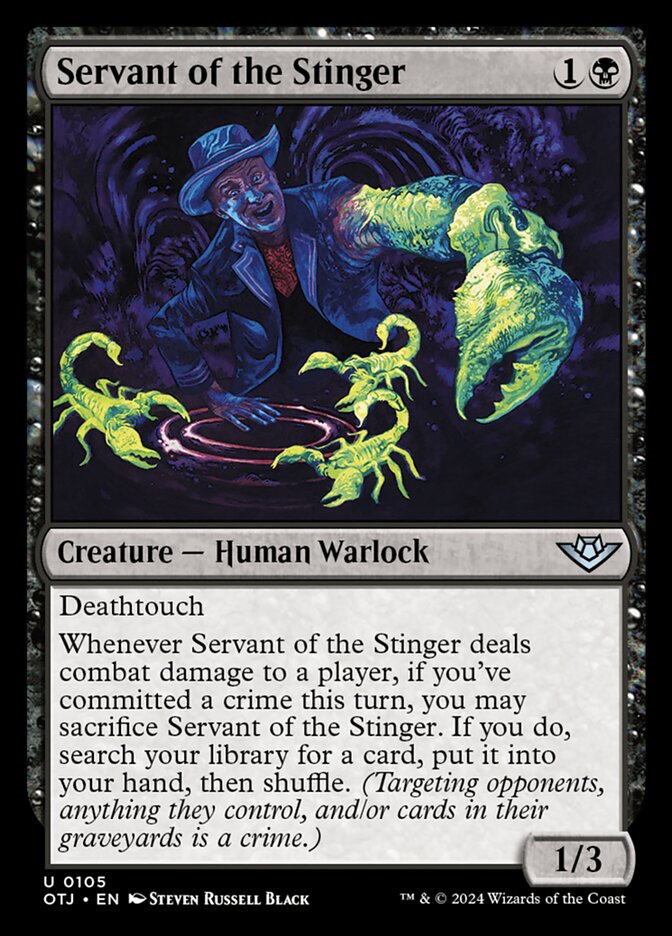
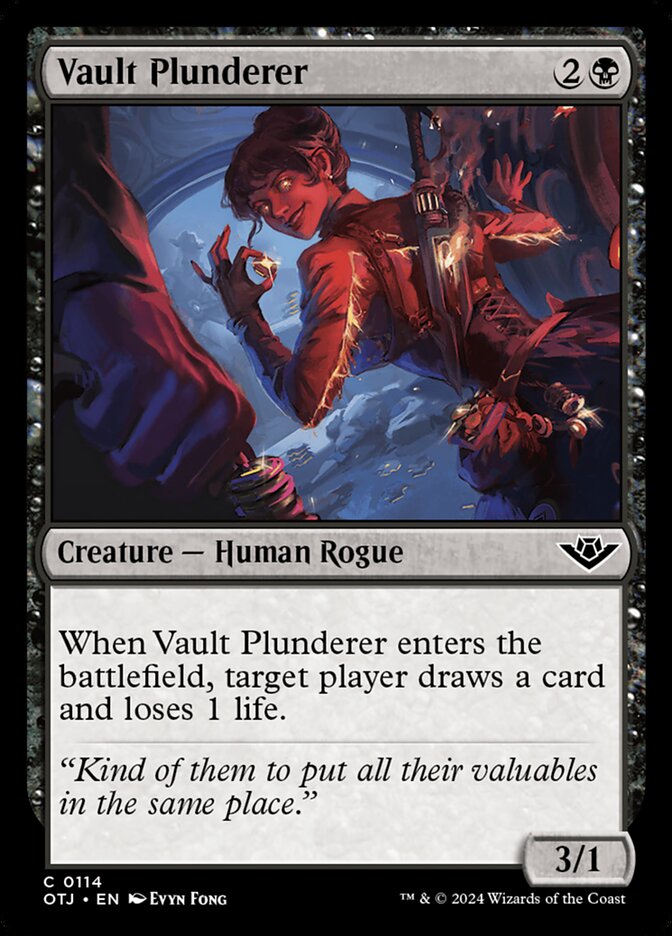
Hollow Marauder: I think the natural flow of a game means you’ll often be able to cast this on turn 5 - and if you work a little harder, it might come down earlier or for a very cheap cost. And once it lands, it provides you with extraordinary value: a 4/2 flier that also forces your opponent to discard a card that also allows you to draw a card if your opponent didn’t discard something good.
Servant of the Stinger: A 1/3 creature with deathtouch for two mana is already a good deal. And if you commit a crime, it either (likely) trades above rate or fetches you any card from your library. That’s amazing!
Vault Plunderer: It’s hard to say no to a cheap creature that draws you a card.
Non-Creature
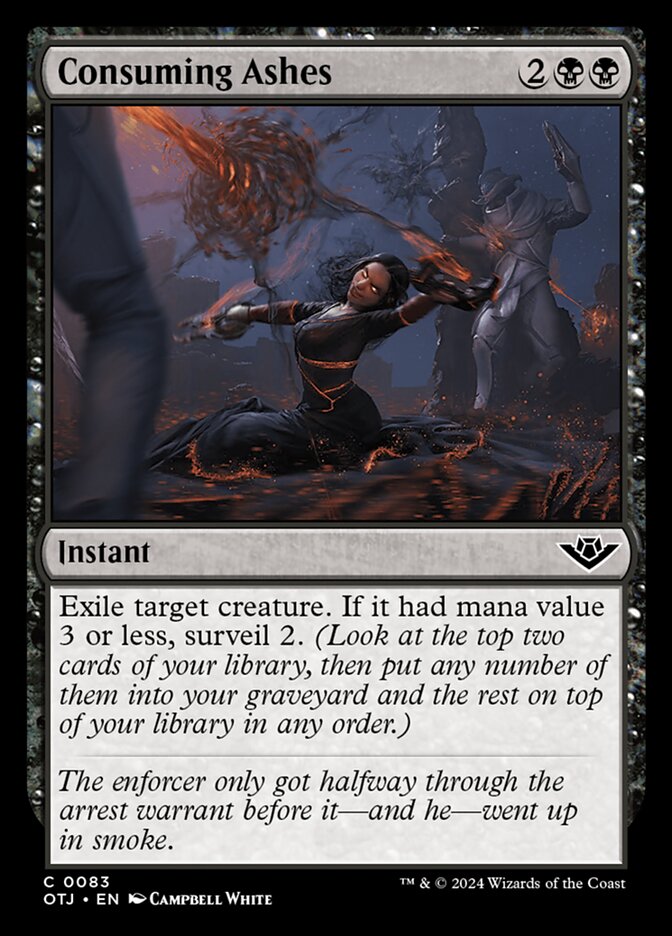

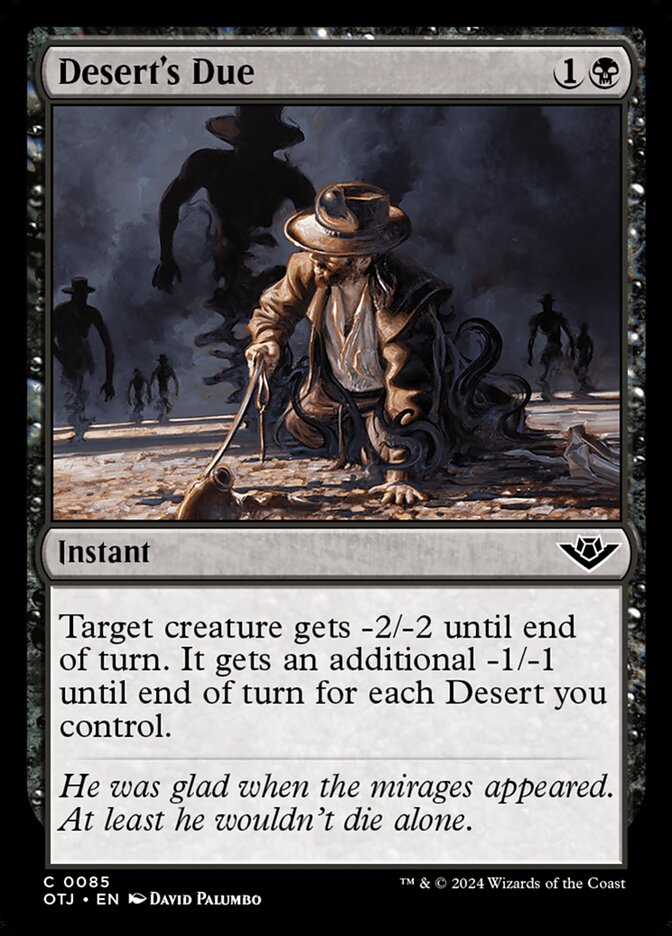
Consuming Ashes: Here’s your four mana unconditional Black removal spell, which exiles and gives you some upside if you’re forced to use it on a cheap creature!
Unfortunate Accident: Here’s your other four mana unconditional Black removal spell, which also gifts you a Mercenary token if you have a single extra mana!
Desert’s Due: Aaaaand here’s a third Black removal spell. Not only is it only two mana; it has the potential to scale quite well if you remember to stock your deck with Deserts.
Red
Creature
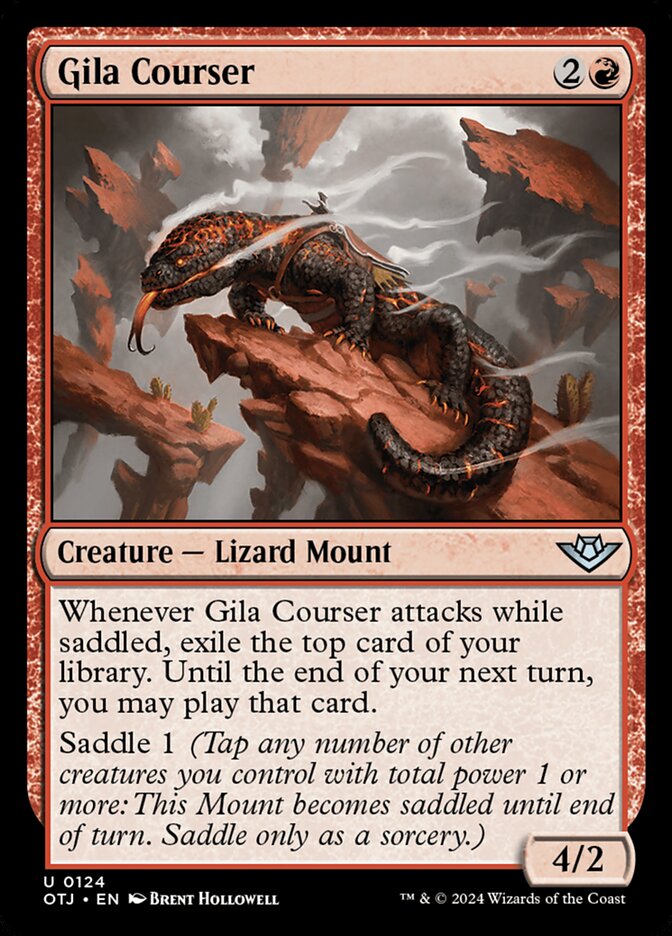
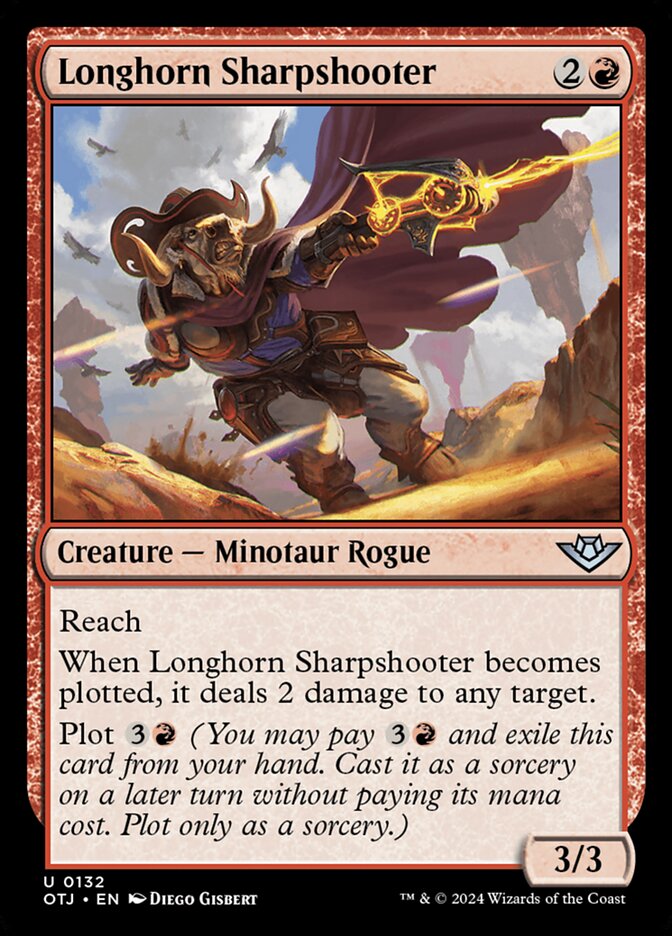

Gila Courser: This Mount doesn’t exactly draw you a card whenever you Saddle it up and attack. But it comes pretty close.
Longhorn Sharpshooter: There are a subset of Plot cards that have an effect when you Plot them. This is one of them, and a free(ish) 2 damage seems pretty good to me!
Mine Raider: Three drops that create a Treasure token when they come into play have proven pretty good in the past. This one requires a little bit of (Outlaw) work to be effective, but I don’t think it’ll be that hard to pull off.
Non-Creature

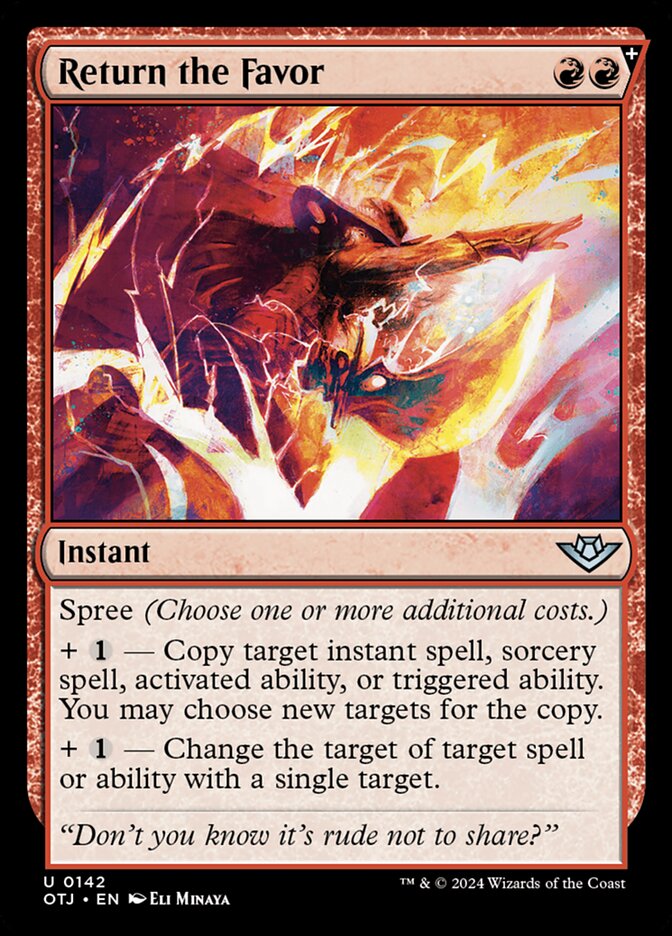
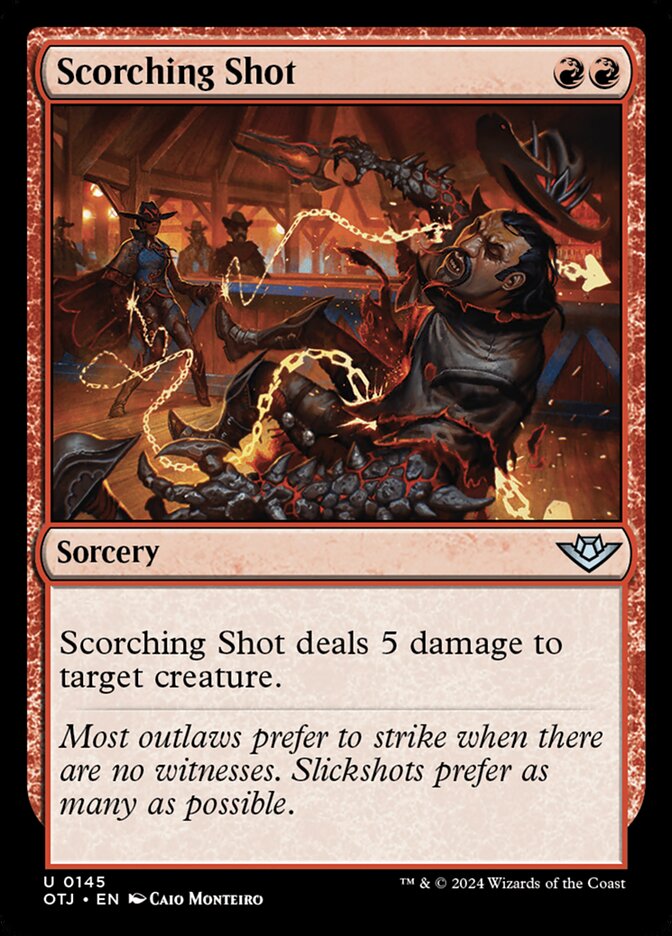
Explosive Derailment: Ah, reasonably costed creature removal with potential upside.
Return the Favor: I admit, copy/redirection spells haven’t been great in past Limited formats. But interaction is high in OTJ, leading me to believe that this one card can lead to massive blowouts.
Scorching Shot: This card does what it says, and what it says is pretty good.
Green
Creature
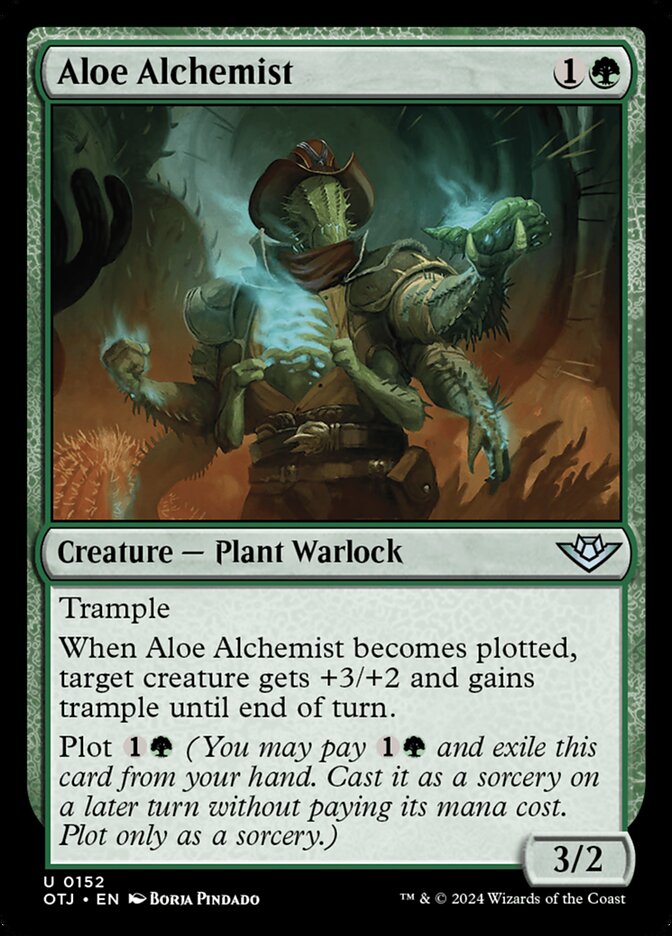

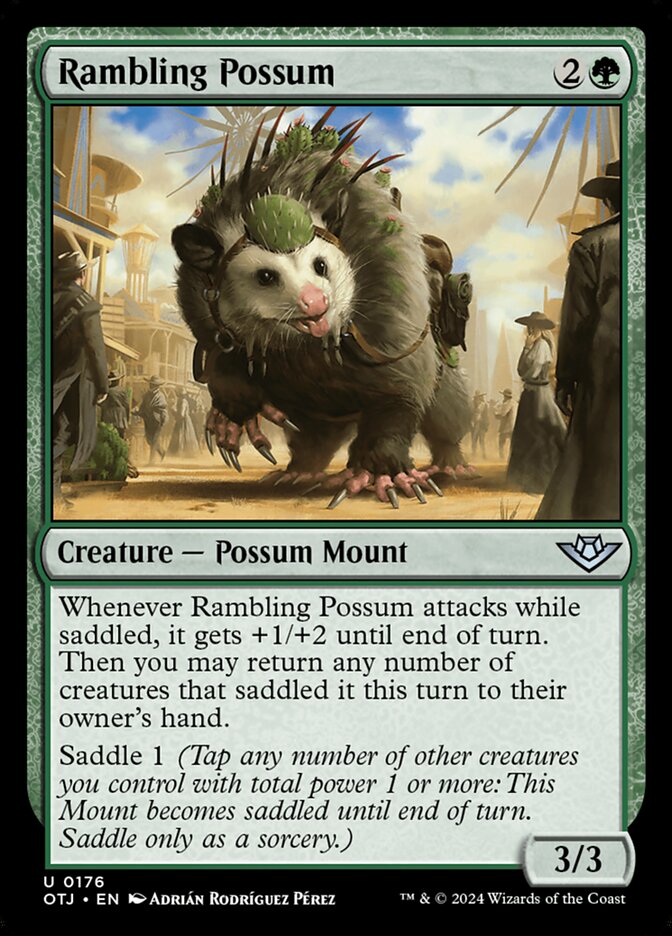
Aloe Alchemist: Sorcery speed creature buffs aren’t great, but one attached to a body seems like a good deal to me.
Cactarantula: This is a defensive beast that will often be played for a discount. And it comes with a card draw consolation prize if your opponent tries to move it aside.
Rambling Possum: Green has a bunch of nicely costed creatures in this set, but I’ll give a special shoutout to this one since its bounce ability goes well with the large number of creatures with cool “enters the battlefield” abilities.
Non-Creature
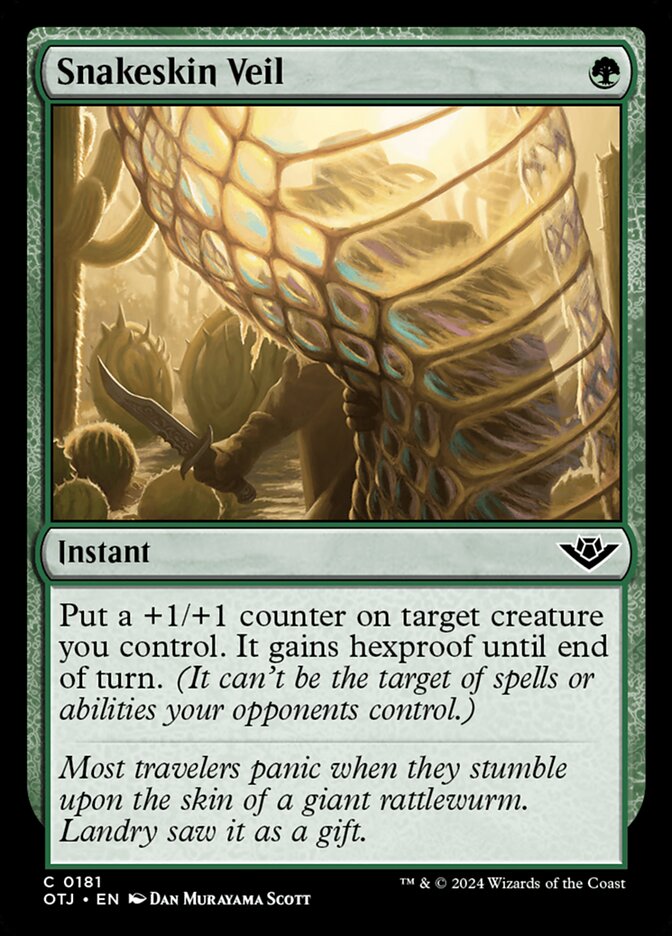
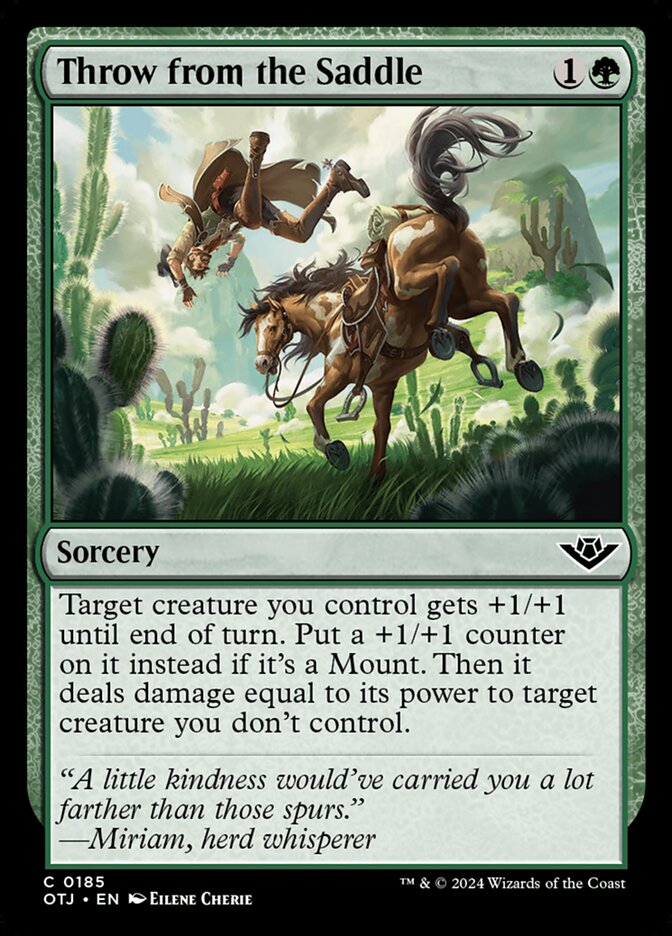
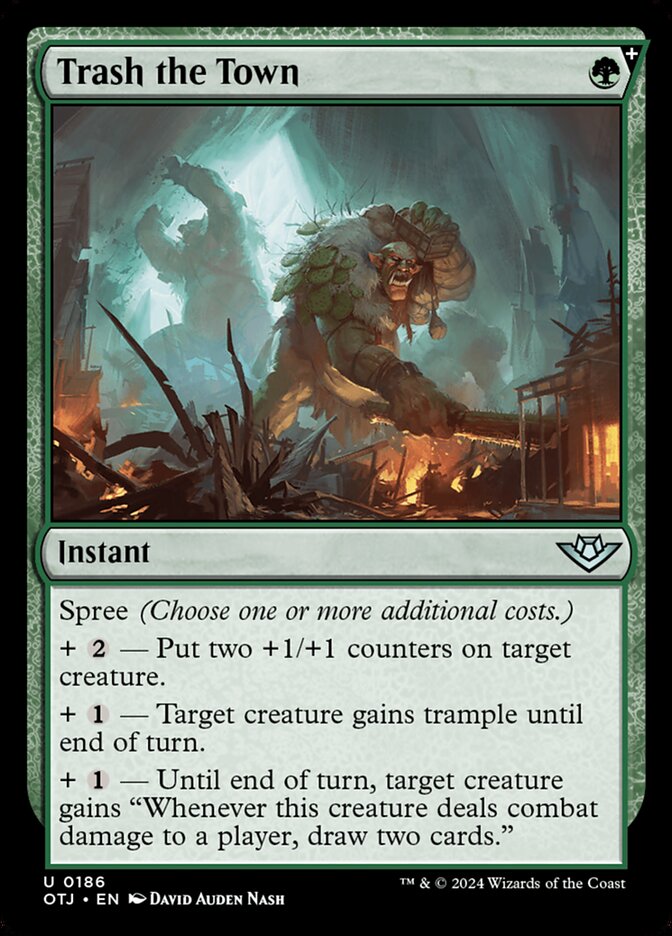
Snakeskin Veil: Cheap hexproof (that even comes with a buff) is gold in a high interaction set.
Throw from the Saddle: Here’s your Green punch spell!
Trash the Town: There’s a ton of text on this card, and each of the options is very good under the right circumstances.
Other Cards to Know
Mana Fixing
There is a ten card cycle of tapped dual lands that can appear in the land slot:
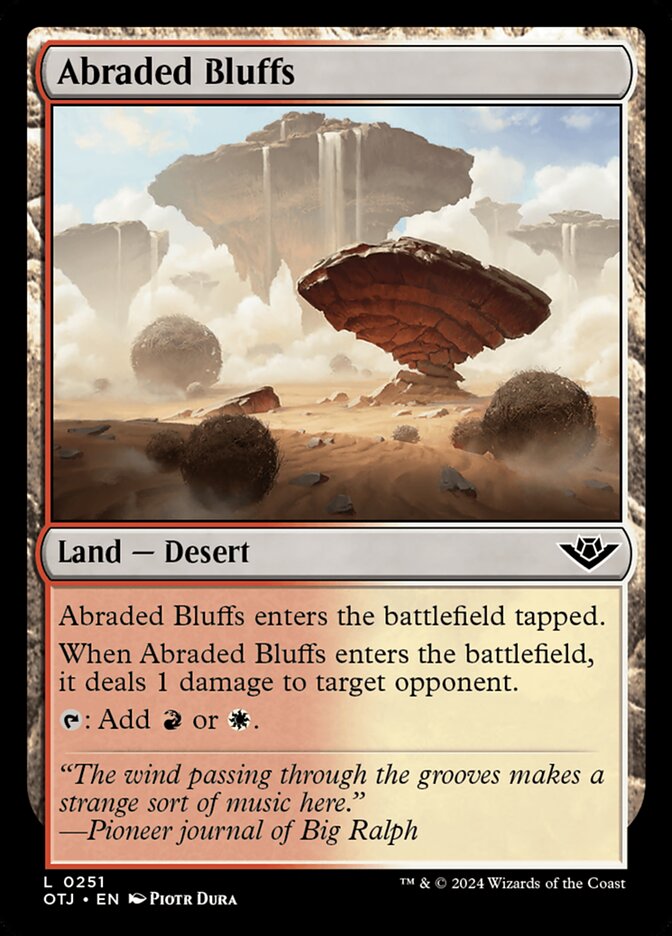
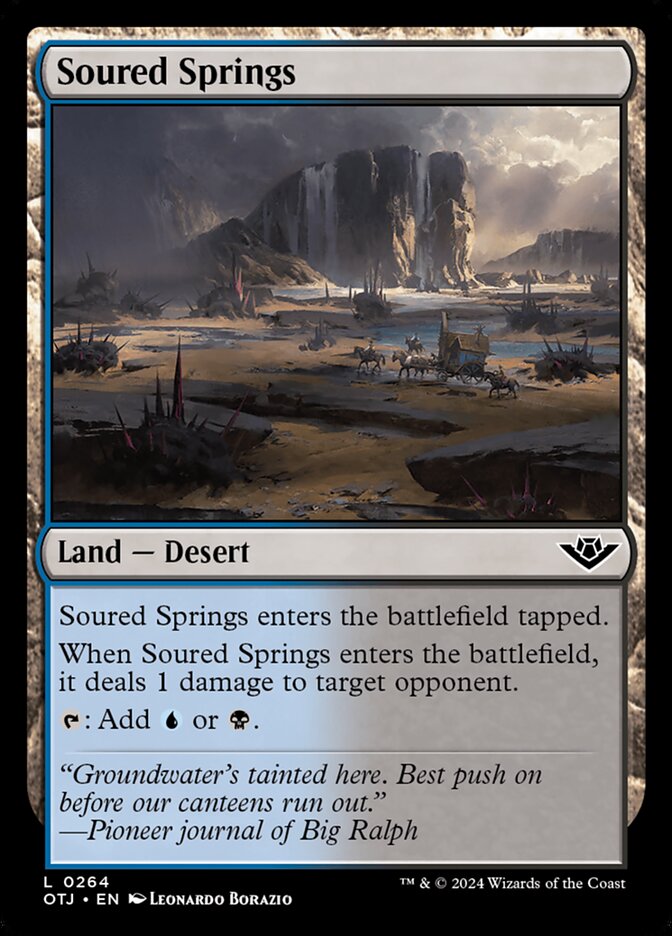
These lands ping an opponent for one damage; notably, it pings a targeted opponent, meaning that these are some vile crime-committing lands. There are additional colorless mana fixing options:
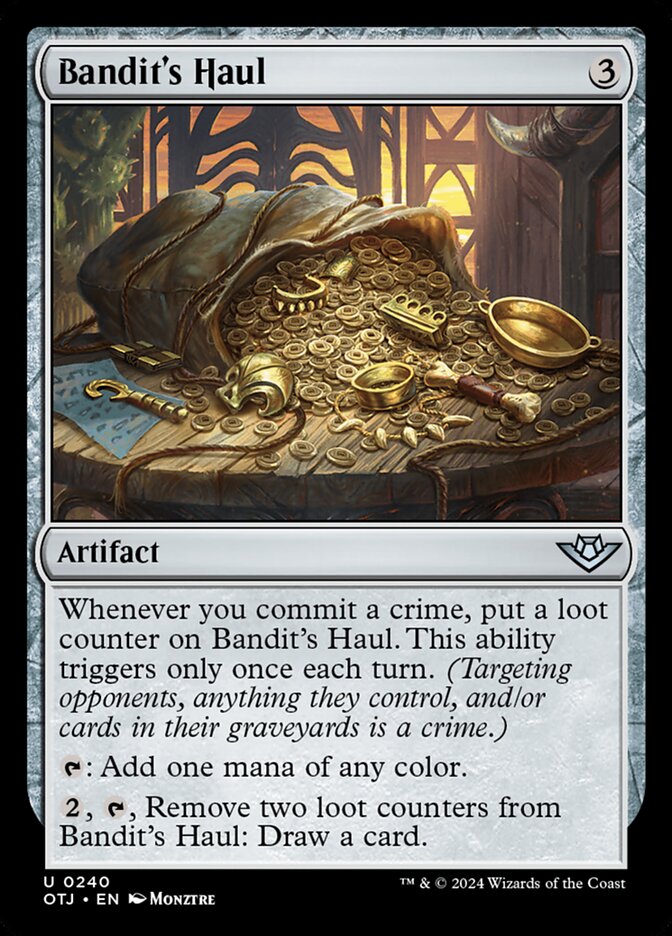

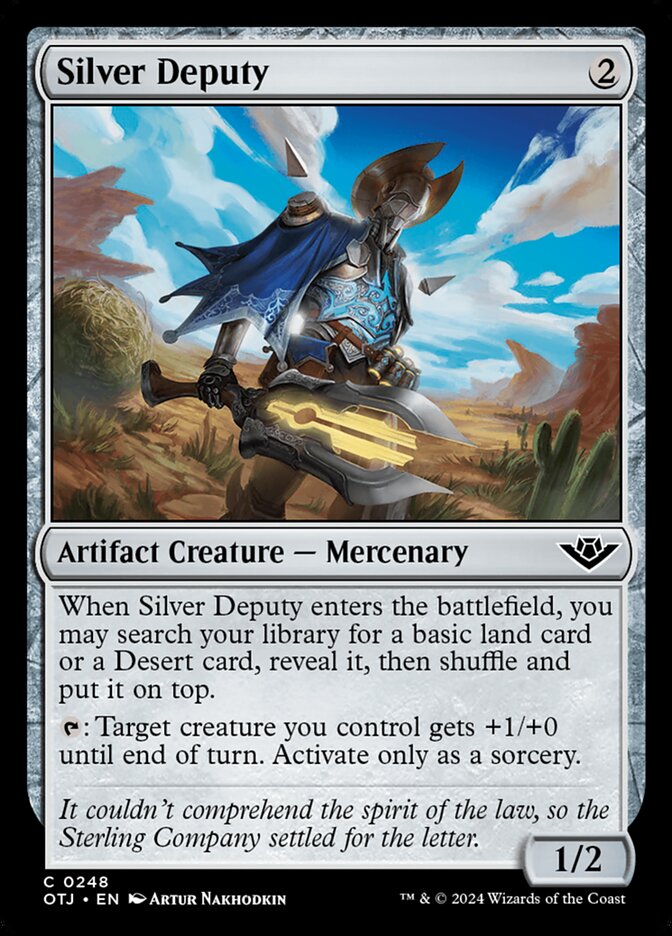

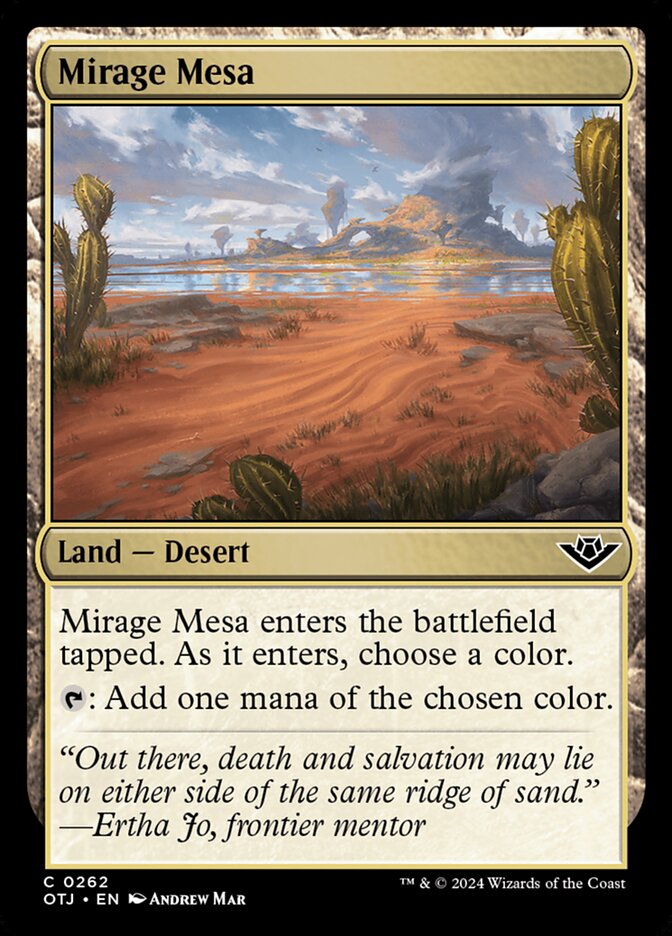
As usual, Green has additional mana fixing options at common and uncommon:

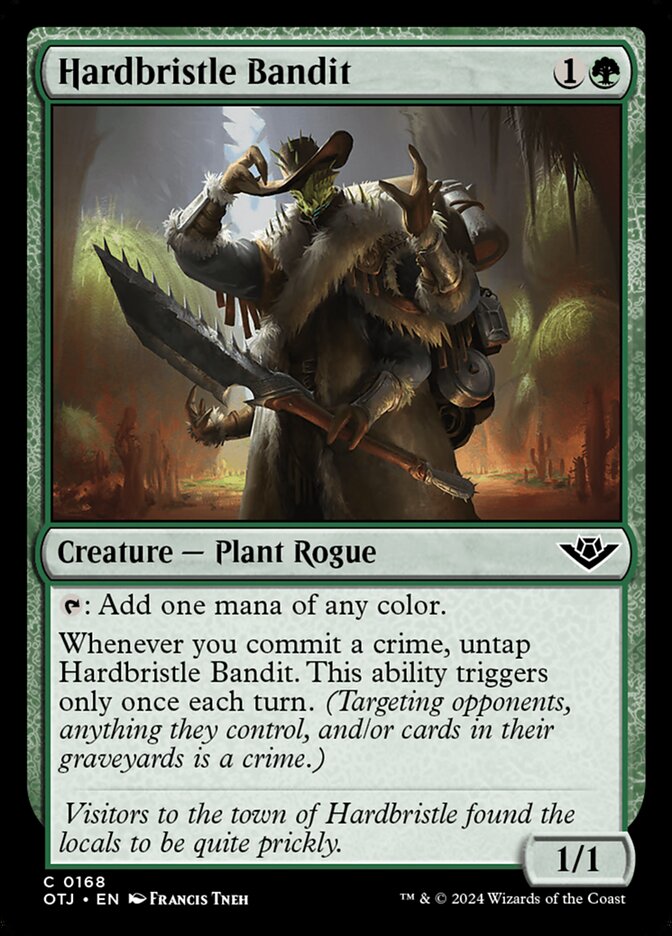
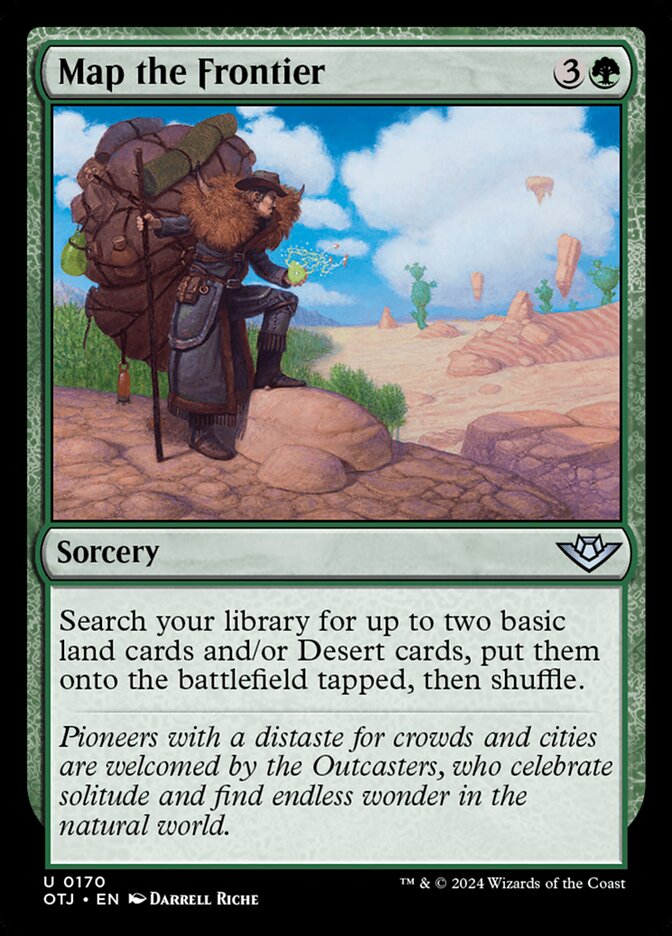

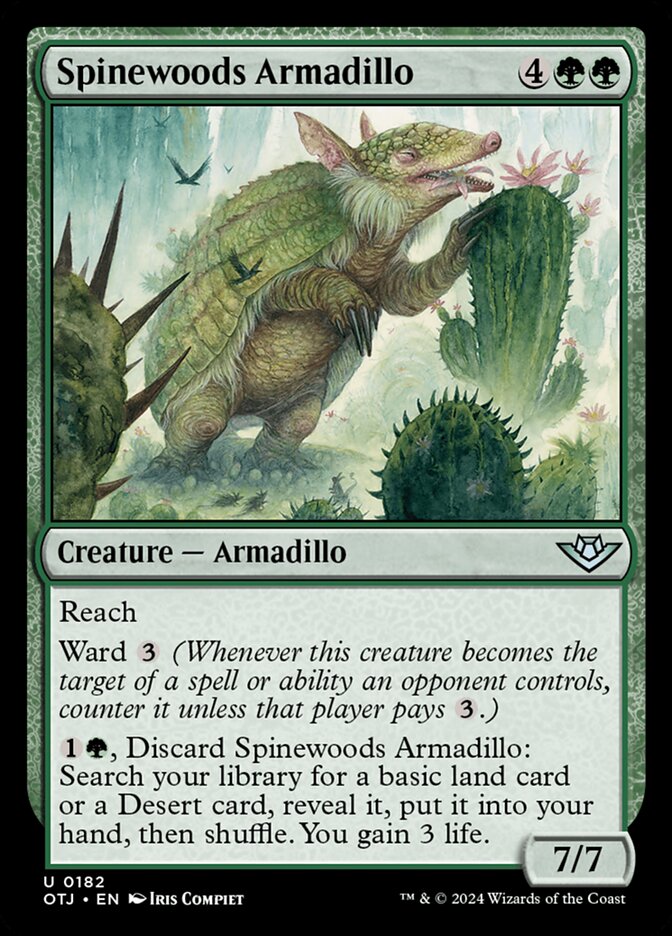
Note that Spinewoods Armadillo is especially good in Black/Green graveyard strategies!
Reach
Here are the common and uncommon creatures with reach. What, you didn’t think that armadillos and cacti could swat down flyers?
Red

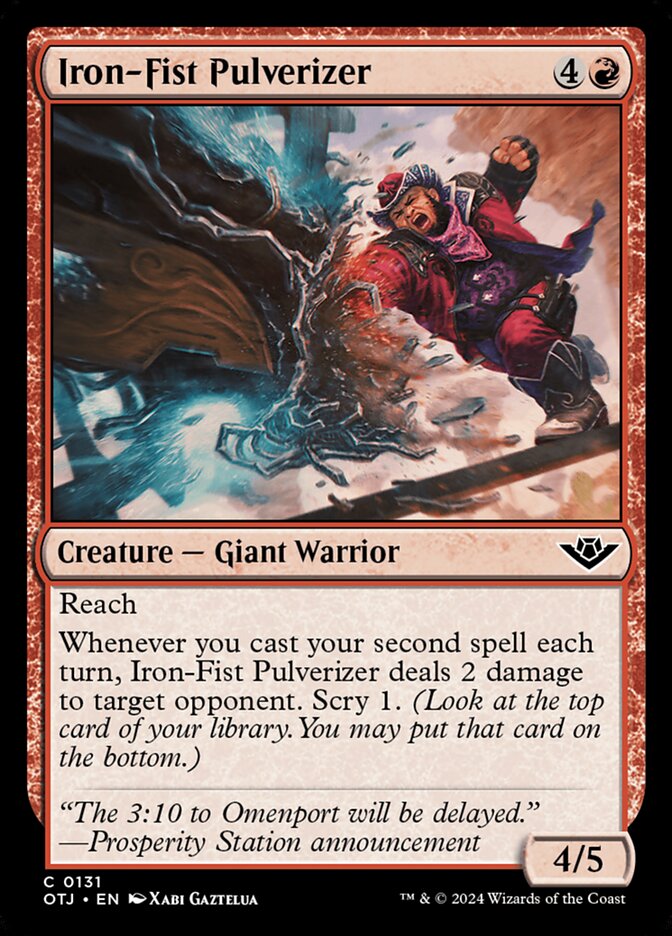

Green



Multicolor

Summation
I’ll start my summary thoughts on Outlaws of Thunder Junction by noting a relatively recent trend: a new set is released, and within a week the masses shout that the Limited format is broken and dominated by aggro decks. This may be true in a few cases, but more often what happens is that the format eventually settles down and players discover that midrange and control strategies are viable after all.
I suspect what’s happening is this: the dawn of a new set is full of people entranced by slower, more complex mechanics, and fundamentals such as removal and early board presence are neglected as a result. Straightforward aggro decks will naturally dominate in such an environment. Make sure this doesn’t happen to you; remember to draft two drops and interaction!
- Along those lines, remember that you don’t need to get full value from Plot and Spree cards. Play a Plot card normally if you’re falling behind on the board; consider casting a Spree card without all of its options if the immediate situation calls for it.
- Many of the creatures in OTJ are extremely powerful with unique effects. Use your removal wisely!
- Limited formats with high amounts of interaction often result in longer games. If you draft an aggro deck, think about how you might eke out those last points of damage on a clogged board.
- At the same time: if you draft a slower deck, keep in mind that you can still fall prey to an opponent that plays aggressive two and three drops backed up by removal spells for your blockers.
- Slower formats trend towards 3+ color decks. Consider picking up the Desert dual lands early.
- This feels like a set that rewards tactical decision making. You’ll have a lot of choices to think about when you look at the cards in your hand; take your time and think through the possibilities and consequences.
Good luck!










